After a wonderful transition between Bolivia and Chile, visiting the incredible Sajama and Lauca National Parks, we headed towards one of Chile’s top tourist destinations: San Pedro de Atacama and its famous desert. We had plans to meet up with my cousin and a friend we met in Cusco for a 4-day road trip around Atacama. We’ll detail our itinerary and all the practical information you need to visit the Atacama Desert, a must-see in Chile!

- Introduction to SPA
- Map of the Atacama Desert
- When to visit the Atacama Desert?
- How to get to the Atacama Desert
- How to get around the Atacama Desert
- Accommodation in the Atacama Desert
- Tips before visiting the Atacama Desert
- 4-Day itinerary around San Pedro de Atacama
- Visit of the village of San Pedro de Atacama
- Things to see by bike around San Pedro de Atacama
- Other things to do around San Pedro de Atacama
We took this trip in 2014, but the article was completely revised and updated in September 2024. If you see any price changes or have additional information that might be relevant, please feel free to leave us a comment!
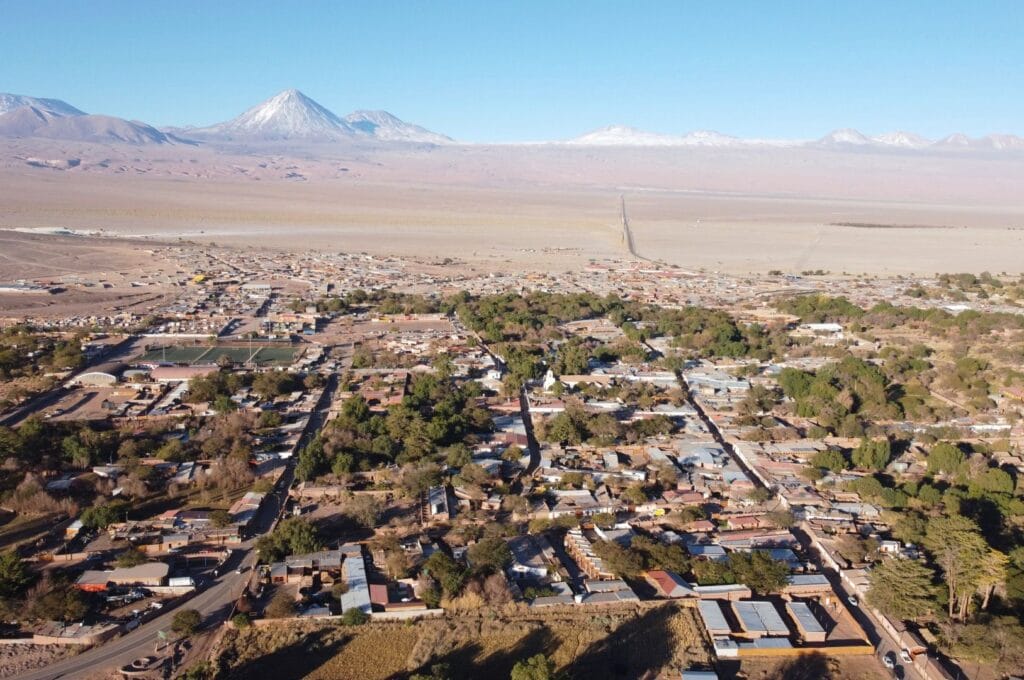
Introduction to SPA
The village and the Atacama Desert
So, San Pedro de Atacama, or SPA as the locals call it, is a village lost in the middle of the eponymous desert in northern Chile! Nestled between the Pacific coast and the Andes mountains, it’s conveniently located near incredible natural landscapes. From San Pedro de Atacama, you can visit one of the largest geyser fields in the world, access the stunning region of Sud Lípez and the Uyuni Salt Flats, marvel at the Valley of the Moon, bike through the Atacama Salt Flats, climb volcanoes, float in a lagoon as salty as the Dead Sea, and much more. Not bad for just one place, right? Of course, nothing is perfect, and there is a catch…
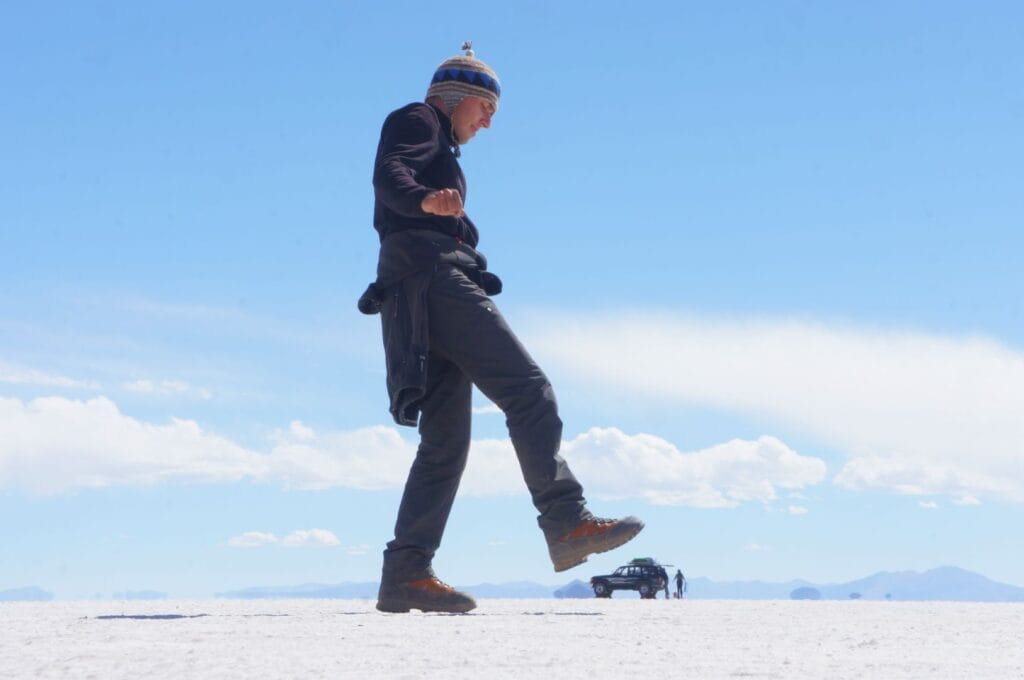
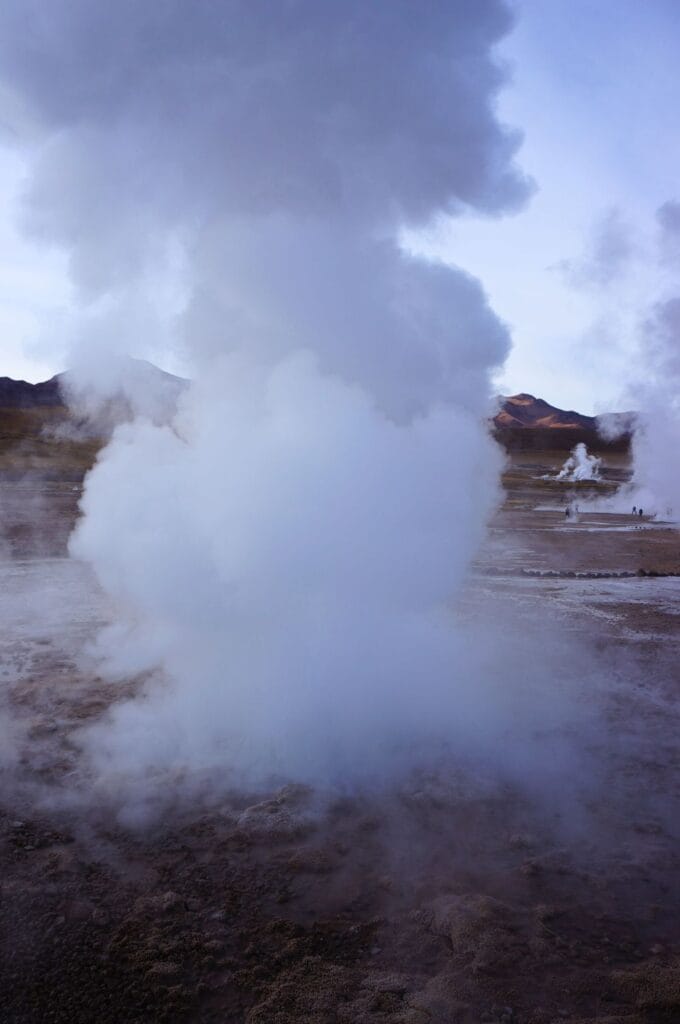
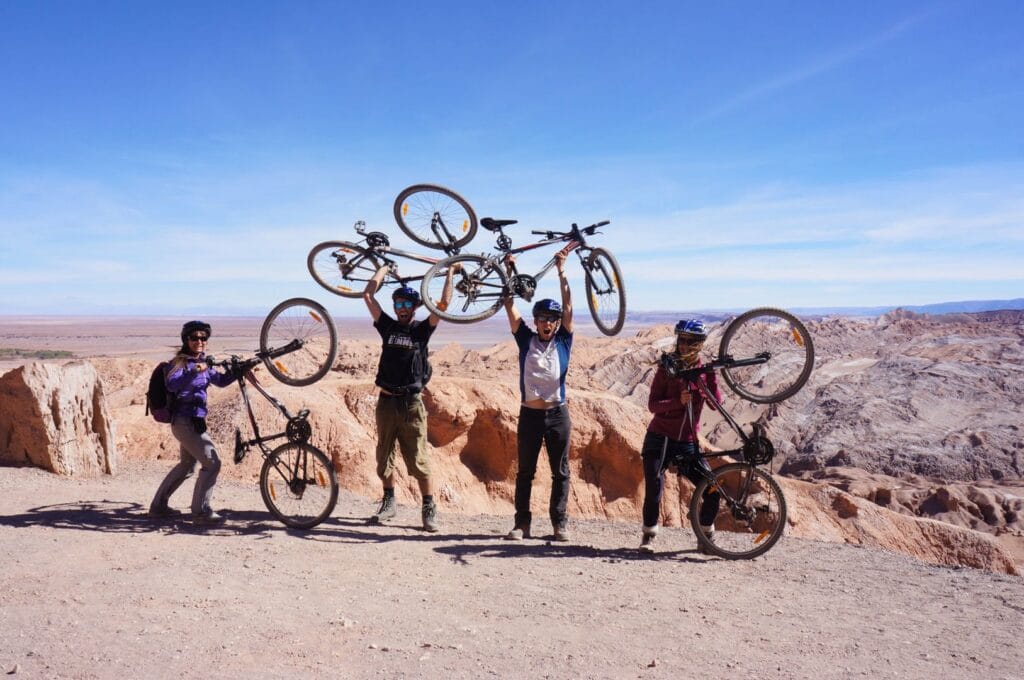
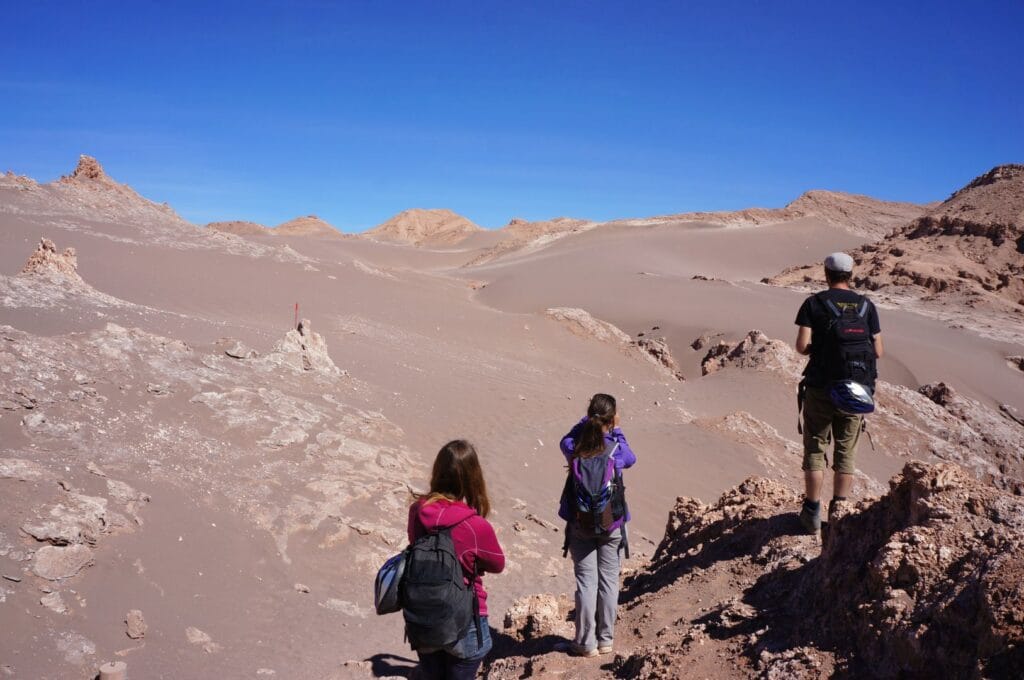
Prices in San Pedro de Atacama
Ouch! Chile, and especially San Pedro de Atacama, is EXPENSIVE when coming from Peru and Bolivia. A dormitory bed? 10-15 euros. A double room? 30-40 euros. A meal at a restaurant? 5-10 euros. Almost like European prices, right? And I haven’t even mentioned the excursions yet! So, with our long-term backpacker budget, it felt a bit like being two broke kids in a toy store. A little frustrating, to say the least… That’s why we decided to camp and cook our own meals during these four days.
Tip: If possible, do your shopping in Calama, the last major city before San Pedro de Atacama. It will be cheaper!
Map of the Atacama Desert
When to visit the Atacama Desert?
Keep in mind that the seasons are reversed in Chile. The austral summer extends from December to February, while the austral winter runs from June to August. Due to the altitude and desert climate, temperature variations are significant throughout the year and are more pronounced during winter. Also, beware of the Altiplanic winter, a little-known phenomenon that occurs especially between January and March, causing torrential rains in the driest areas!
The most popular time to visit Atacama is during the austral winter, from June to August. To avoid the crowds while enjoying milder temperatures, we recommend visiting during April and May, or from September to December.
How to get to the Atacama Desert
From La Paz
From La Paz, Bolivia, opt for this 5-day tour combining Uyuni and Atacama if you only want to visit the Atacama Desert. Otherwise, the simplest and cheapest way is to take a bus from La Paz to Uyuni, spend a few days at the Salar, and then take a second bus from Uyuni to San Pedro de Atacama.
By air, there are no direct flights between La Paz and Calama, the nearest airport to Atacama. Most flights make a stopover in Lima and Santiago. So, you’ll spend more time waiting for your connection than anything else!
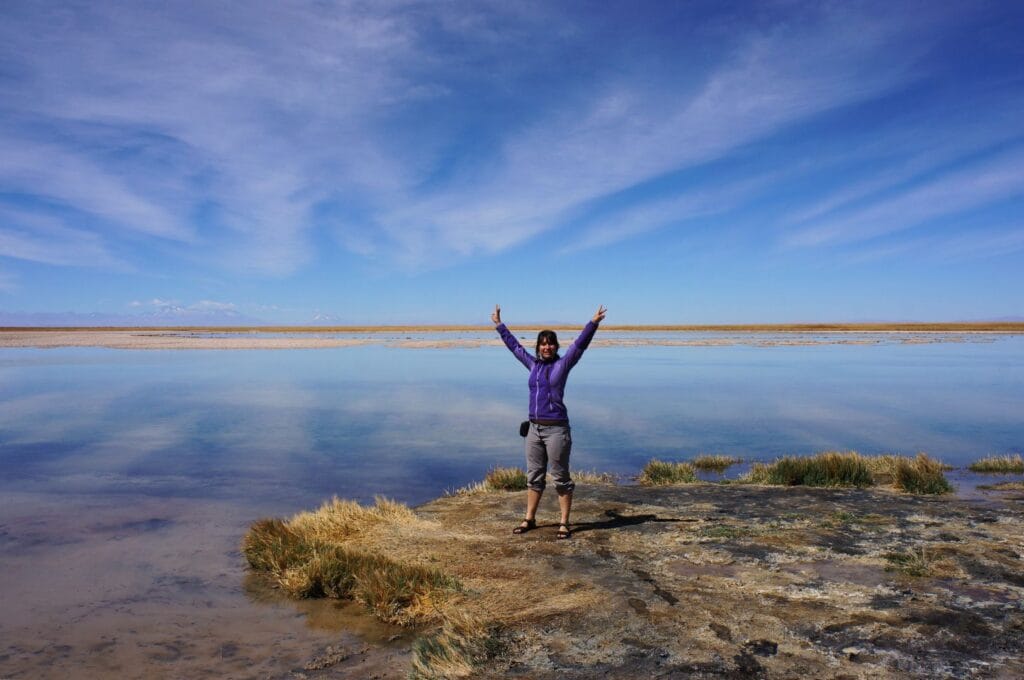
From Lima
From Lima, the Peruvian capital, it’s the same: you won’t find a direct flight to SPA; you’ll pass through Santiago to get to Calama. Find all the tickets here. The total travel time is about 12 hours for a flight ticket costing around 85,000 pesos.
From Arica
We arrived in San Pedro de Atacama by bus from Arica, in the extreme north of Chile. As the journey takes about 11 hours, you’ll be traveling overnight. Bus tickets cost 15,000 pesos per person for a semi-cama seat.
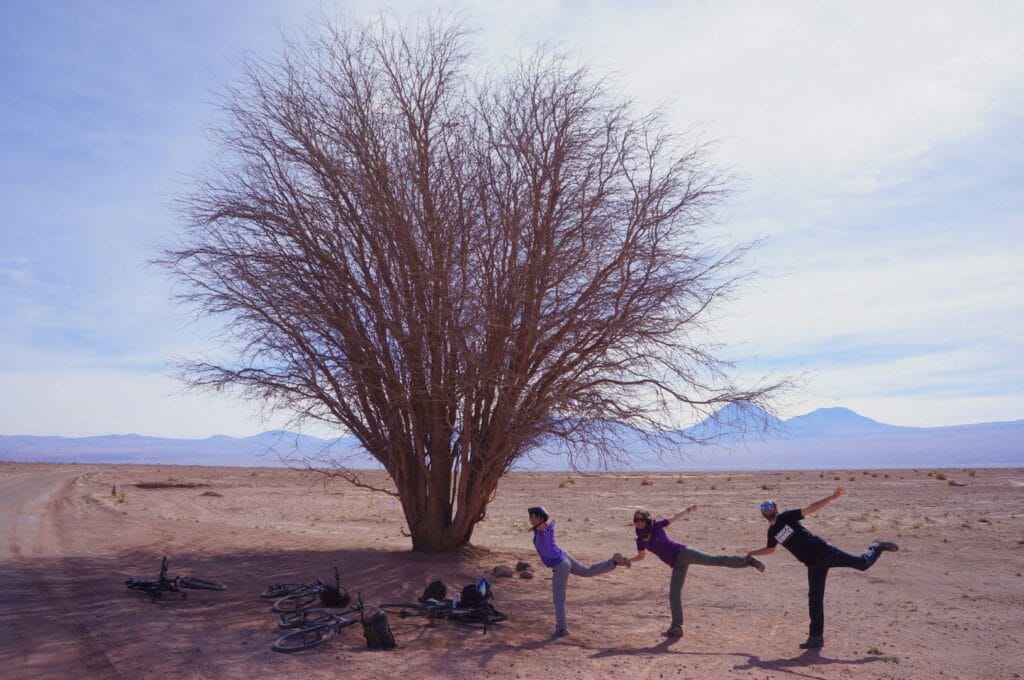
From Valparaíso and Santiago
From Valparaíso, the easiest way to get to Atacama is to first take this bus to Santiago (2,000 Chilean pesos for a 2-hour bus ride). Then, you have the choice between:
- taking 2 buses:
- between Santiago and Calama (starting from 26,000 Chilean pesos for a 20-hour bus ride)
- then, between Calama and San Pedro de Atacama (around 4,000 pesos for less than 2 hours of travel)
- flying: several flights connect Santiago to Calama, the nearest airport to San Pedro de Atacama. A plane ticket costs about 21,000 pesos for a 2-hour flight. Then, you’ll need to take a bus from Calama to SPA.
Another option is to rent a car from Calama if you plan to do a road trip through northern Chile or book a transfer directly to your hotel.
From Salta in Argentina
From Salta, night buses depart at 1:00 a.m. and arrive in SPA at 11:30 a.m. A semi-cama ticket costs 60,000 pesos per person.
How to get around the Atacama Desert
Renting a bike
To cut costs, you can always visit a place by sacrificing a bit of comfort and breaking out in a sweat. So, we spent 2 out of 4 days biking through the Atacama Desert. Since the terrain is relatively flat, covering long distances is fairly easy. For bike rentals, we recommend the Ciclo Aventura Atacama agency. For 8,000 pesos per bike for a 6-hour duration, you’ll get a good bike and all the necessary equipment. Don’t forget to check everything on your ride before setting off: brakes, suspension, gears, saddle, etc.
As for activities, SPA is quite close to the Valley of the Moon (10-15 km) and Laguna Cejar (20-30 km) north of the salt flats. If the idea of pedaling and sweating in the desert doesn’t scare you, you can already visit these two must-sees of San Pedro de Atacama on a tight budget! We’ll cover these activities in the second part of the article.
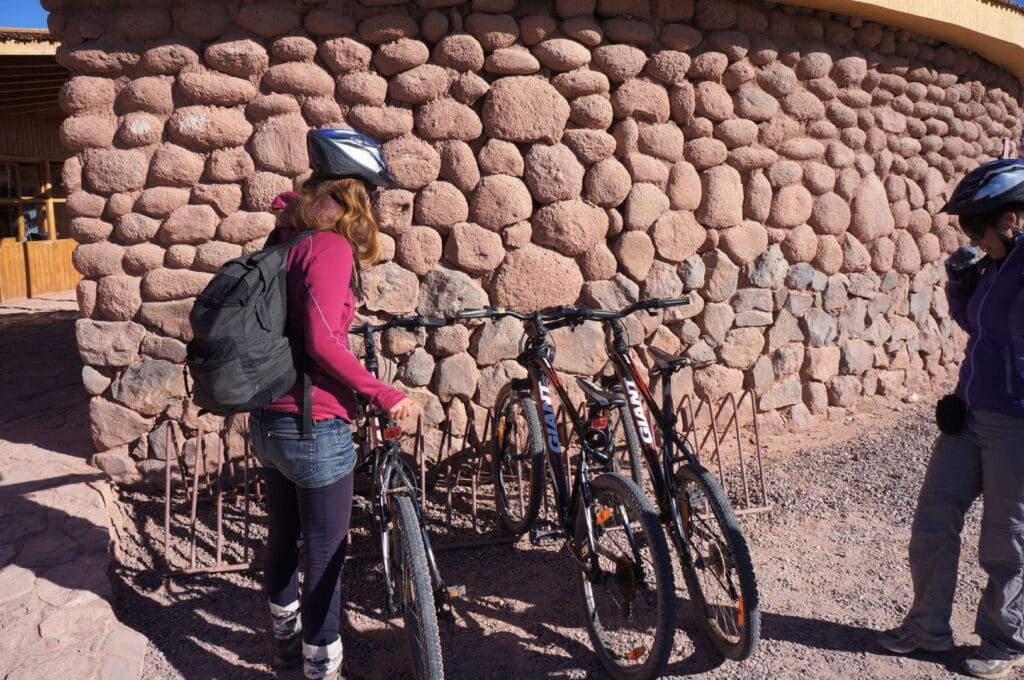
Renting a car
Renting a car is undoubtedly the most popular way to tour Atacama. If you can, rent a vehicle from Calama. That way, you’ll have more options and ensure to get a car, as there are only two rental agencies in San Pedro de Atacama. Prices start at 120 euros (121,000 pesos) for a 4-day rental. Don’t hesitate to rent crossover vehicles, 4×2 or even 4×4, anything higher than compact cars, to maneuver freely in the desert.
Note: It seems that rental agencies only accept credit cards, not debit cards, which are more commonly used in everyday life. Be sure to check with your bank.
Taking a guided tour
Another option is to take a guided tour from La Paz or from San Pedro de Atacama. Ranging from one day to several days, everything is possible! It all depends on what you want to do. We detail all the possible activities around SPA later in the article :).
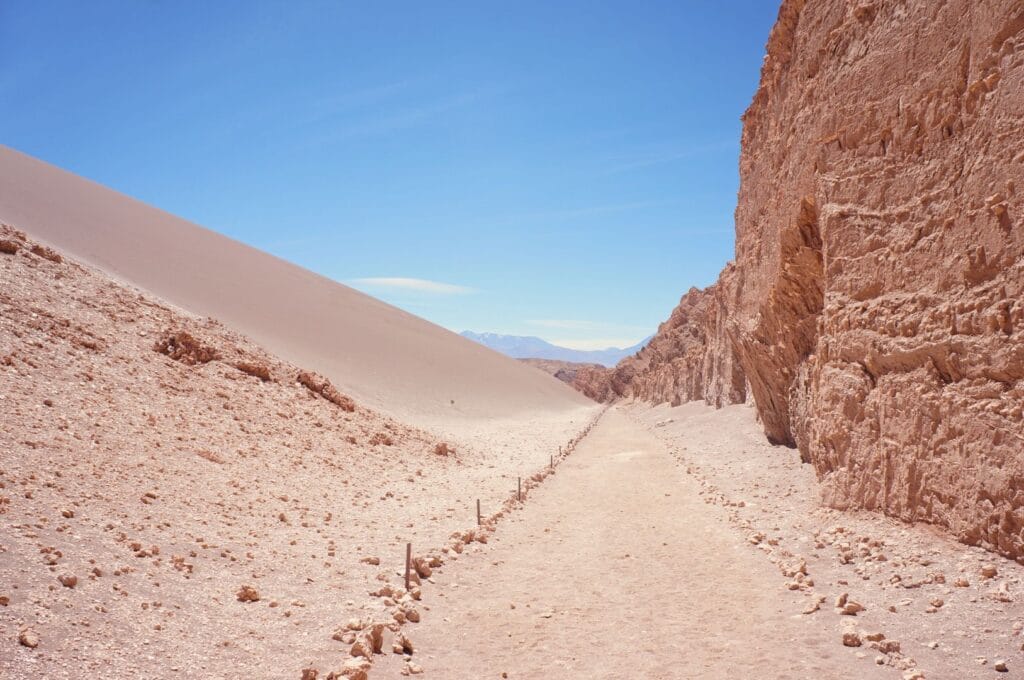
Accommodation in the Atacama Desert
To explore the Atacama Desert, you’ll have no choice but to stay in San Pedro de Atacama. This will allow you to explore the area each day.
Camping
As for us, we don’t travel light, mainly because of the camping gear. So, when we arrive in places like San Pedro, we don’t hesitate for a second and look for a place to camp.
The cheapest place to camp in Atacama is called La Casa Del Sol Naciente. You’ll find sandy spots and even old mattresses to put under your tent for added comfort. Camping costs 6,000 pesos per person per night.
Hotels and hostels
La Casa Del Sol Naciente also has dorm beds and double rooms. The internet works well, and a kitchen is available for travelers. We also recommend two other hostels: Casa Voyage Hostel with its pool and Misky Wasi. Both are very well located and offer dorm beds at low prices, as well as double rooms. For a bit more charm, we also suggest Ckoinatur Hostel, which offers great value for money with breakfast included.
Tip: As Atacama is very touristy, we highly recommend booking your accommodation in advance. The good, cheap rooms go quickly!
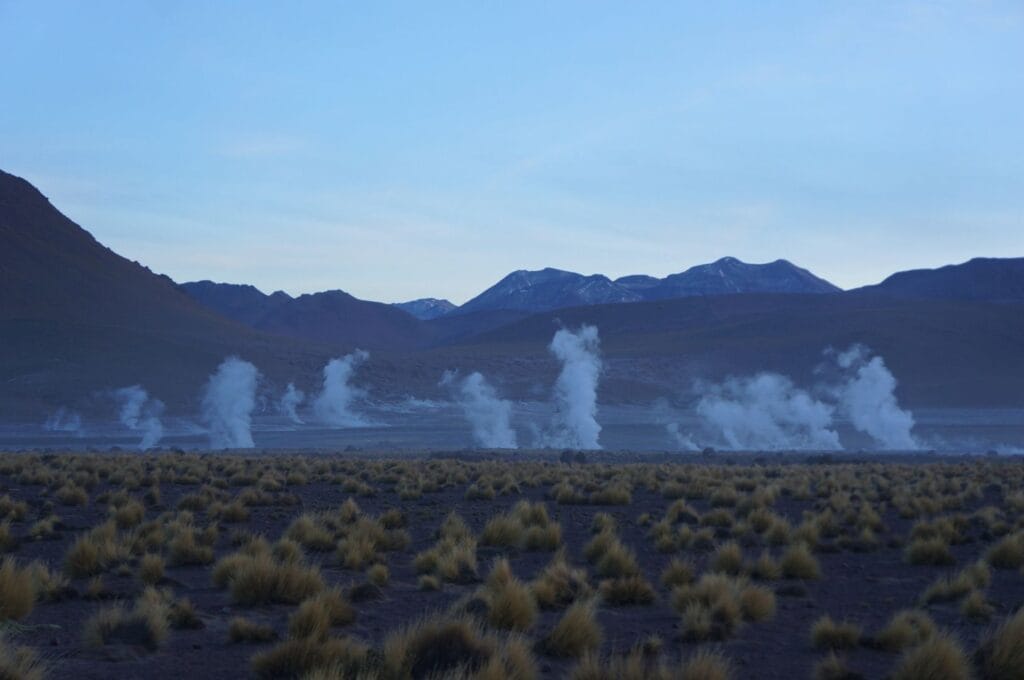
This article contains affiliate links to partner sites. When you use our links to book accommodation, a car, or an activity, you don’t pay anything extra, but we get a small commission. This helps us to offer you free, independent, and ad-free content. Thank you for your support!
Tips before visiting the Atacama Desert
Altitude
Altitude is probably the last thing on your mind when planning your visit to Atacama. If you’re coming from a place at sea level (0 m altitude), you’ll definitely feel the difference upon arrival! San Pedro de Atacama is located 2,500 meters above sea level. Some places in the Atacama Desert reach almost 4,000 meters! And that’s not counting the volcanoes, whose summits are over 6,000 meters. So, to handle this elevation, there’s only one solution: acclimatization! Stay a few days in SPA to get used to the altitude; you shouldn’t be out of breath at the slightest effort before tackling the salt flats. Otherwise, you risk altitude sickness, find all our tips to avoid it here.
Sun
Due to the altitude, be careful with the sun throughout the region! The Atacama Desert is one of the driest areas in the world, and the sun is intense! We recommend wearing long-sleeved tops and bringing a cap and plenty of sunscreen to avoid getting burned. Don’t miss any part of your body: with the reflection of the rays on the salt flats, you’ll burn even your armpits. And of course, make sure to bring plenty of water, at least 2 liters per person per day. Keep extra water in your rental car, just in case.
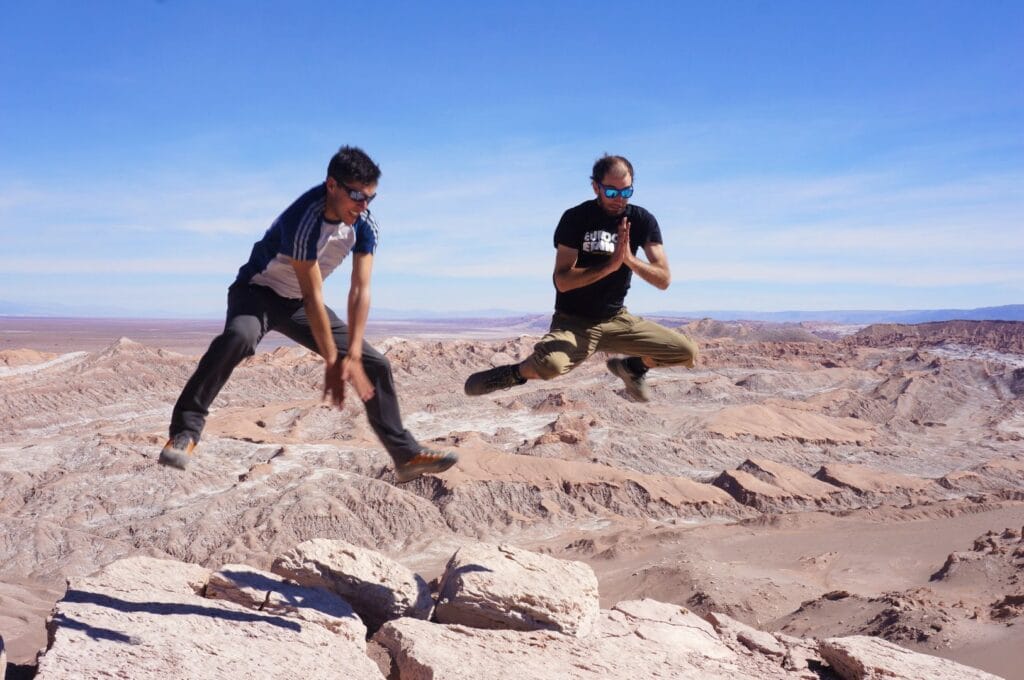
Cold
When thinking of an arid desert, you might assume it’s hot, but that’s not always the case due to the altitude! Be wary of the wind that picks up in the afternoon; it can blow quite strongly. We really recommend driving as much as possible in the morning. Make sure to dress warmly at all times! The best approach is to bring multiple layers of clothing to adapt to the changing temperatures of the desert.
Money
Although there are ATMs in San Pedro, we recommend withdrawing money in Santiago (or Calama if necessary) before arriving. The card isn’t always accepted in SPA, and the city’s ATMs often run out of cash…
Fuel
The only gas stations in the desert are in San Pedro de Atacama. Be aware that they often run out of fuel as well! So, don’t hesitate to refuel every day, especially with such long distances to cover.
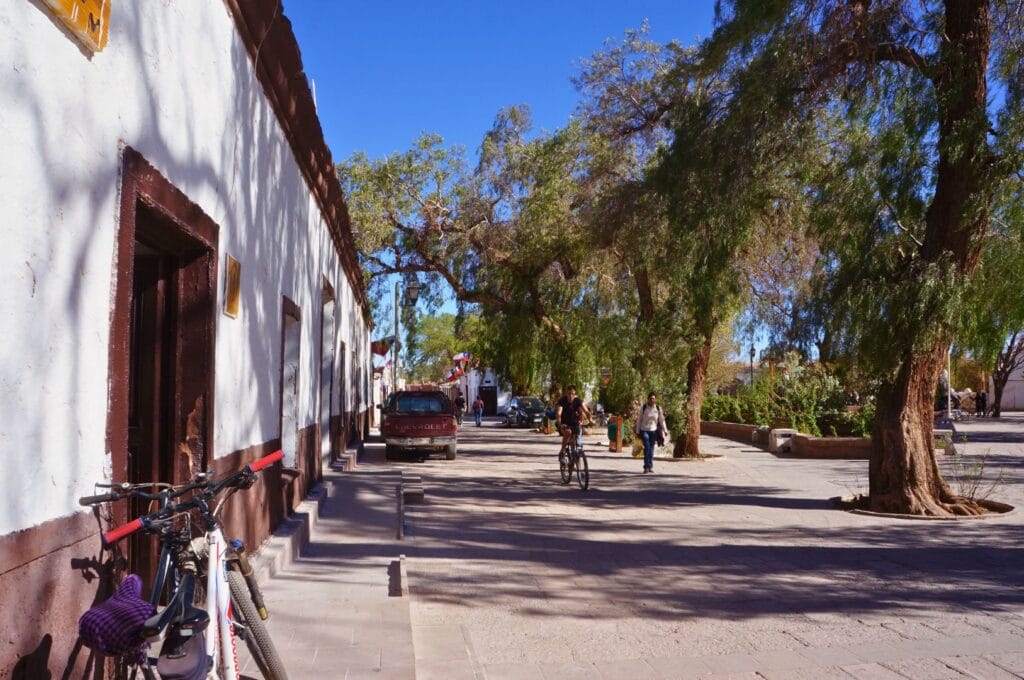
4-Day itinerary around San Pedro de Atacama
To help you organize your trip, we’ve adjusted our 4-day itinerary for visiting Atacama. We didn’t count the acclimatization days since we were already used to the altitude. However, we optimized it for gradual elevation gain. We recommend staying at least 4 days in San Pedro de Atacama. While you won’t be able to do everything, in 4 days, you’ll see the essentials in different areas of the region and maybe more.
Day 0: arrival in San Pedro de Atacama
On the road between Calama and San Pedro de Atacama, take the opportunity to visit all the sites north of SPA. This way, you won’t need to retrace this route on another day.
- Valle del Arcoiris and Yerbas Buenas
- Discover SPA and stroll through the streets
- Pukará de Quitor
- Sunset at Mirador Likan-Antay (free), accessible on foot, by bike, or by car
Day 1: Western Atacama by bike or car
- Aldea de Tulor
- Valle de la Luna
- Valle de la Muerte (or Valle de Marte)
- Sunset at mirador de Kari
Day 2: Southern Atacama by bike or car
- Laguna Cejar and Laguna Piedra
- Los Ojos del Salar
- Laguna Tebinquiche
Day 3: Southern Atacama by car
- Laguna Chaxa
- Tropic of Capricorn
- Lagunas Miscanti y Miñiques
- Piedras Rojas
- Salar de Talar
- Mirador Laguna Tuyajto
Day 4: Northern Atacama by car
- Geysers del Tatio
- Mirador Putana
- Mahuca
- Puritama hot springs
- Guatín Canyon with its giant cacti
If you plan to stay 5 days or more in San Pedro de Atacama, find all the activities and places to visit later in the article and on the desert’s map to create your itinerary.
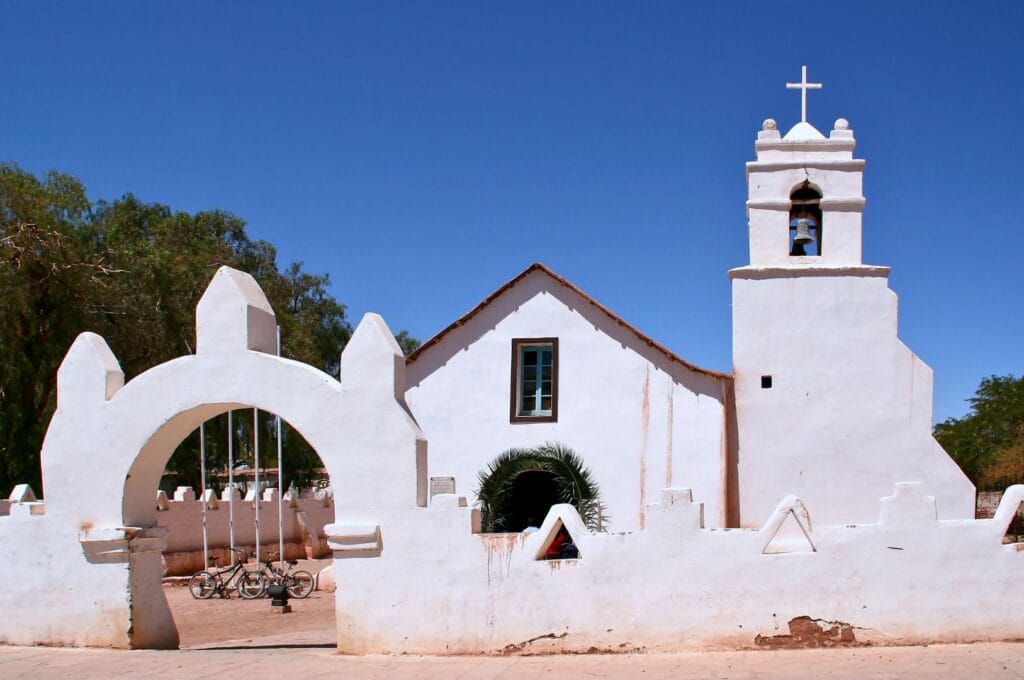
Visit of the village of San Pedro de Atacama
Streets and buildings
Let’s be honest, you’ll quickly see all there is in the village of San Pedro de Atacama. Don’t hesitate to stray from the town center, almost entirely devoted to tourism, and stroll through streets lined with adobe houses. Also, don’t miss the iconic church of SPA on the main square. You’ll also find artisans showcasing their crafts all around the village.
Meteorite Museum
This museum is run by enthusiasts who have collected over 6,000 meteorites that fell in the Atacama Desert, making it the largest meteorite collection in the world! The 70 most significant ones are on display. An audio guide in English is provided to explain the history of these unique rocks engagingly. The ticket costs 5,000 Chilean pesos per person. The Meteorite Museum is open every day except Monday, from 5 p.m. to 8 p.m.
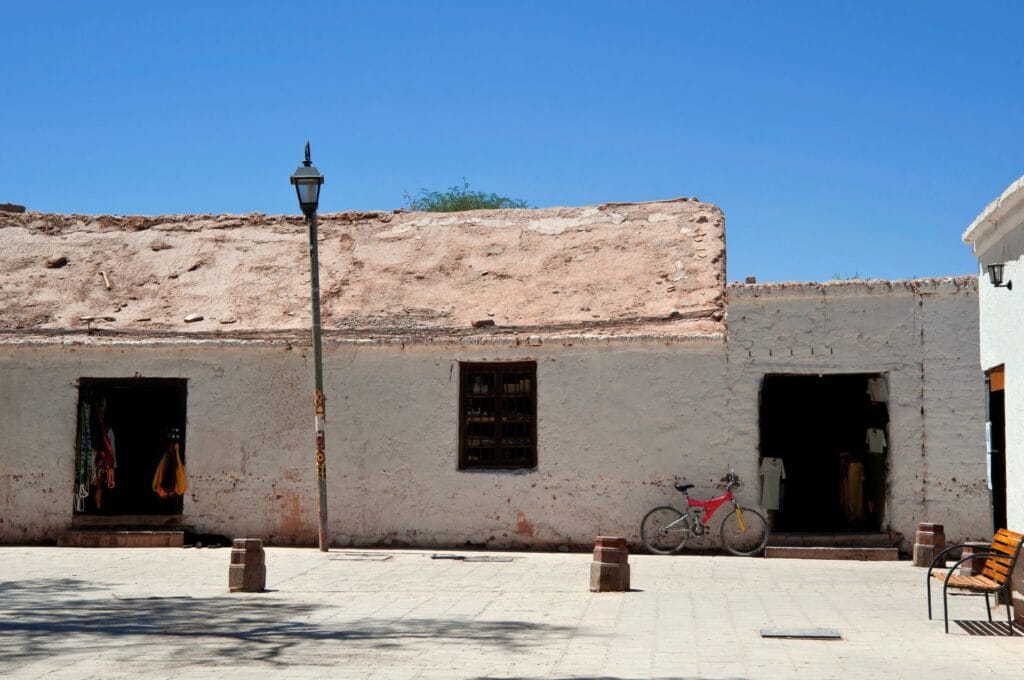
Things to see by bike around San Pedro de Atacama
Several things to keep in mind before planning your visit to the Atacama Desert:
- most sites charge an entry fee;
- their opening hours are not all the same;
- and sometimes, it’s necessary to book in advance.
For a complete schedule, we recommend a quick visit to Sernatur, the SPA tourist office. We’ll provide the current information for each point of interest at the end. Keep in mind that these details are subject to change.
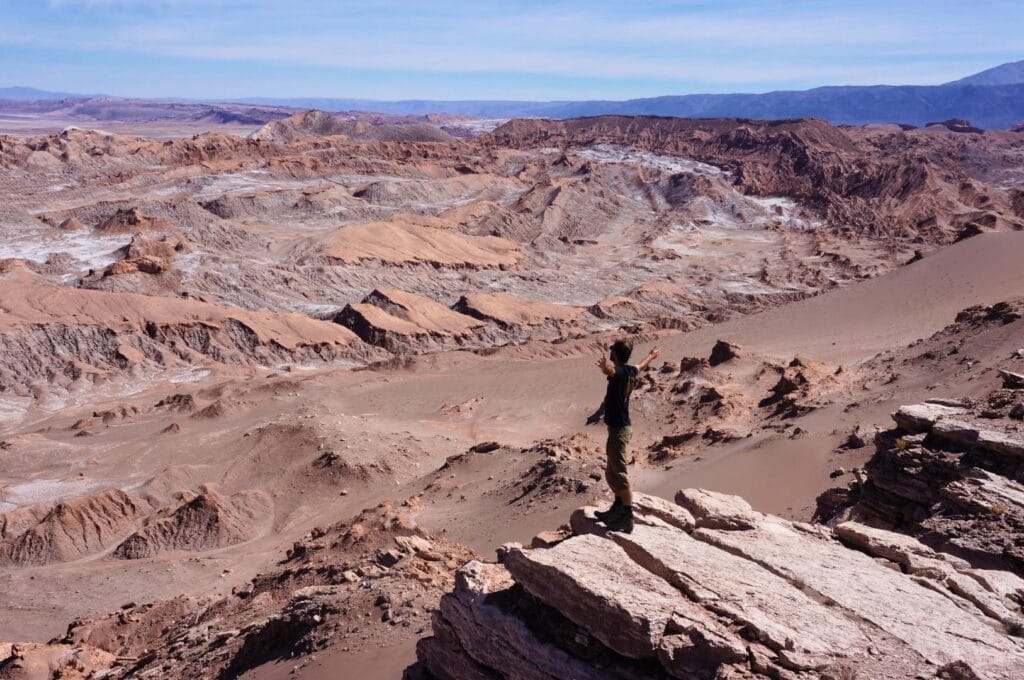
The Valley of the Moon
Located 13 kilometers west of San Pedro, in a section of the Los Flamencos Nature Reserve, the Valle de la Luna will leave you in awe. You’ll see caves and dunes with lunar-like landscapes that blend with strange rock formations. The Valley of the Moon stretches about ten kilometers with a track running through it. Among the points of interest to visit, we recommend:
- Duna Mayor: a huge dune with a trail all around it, a popular spot for sunset;
- the Amphitheater (anfiteatro) of the Atacama Desert: this massive rock formation has been shaped over centuries by natural elements, giving it the appearance of a Roman amphitheater;
- Las Tres Marías if you have time, these are less impressive than the Amphitheater—small rock formations eroded by the desert’s weather conditions.
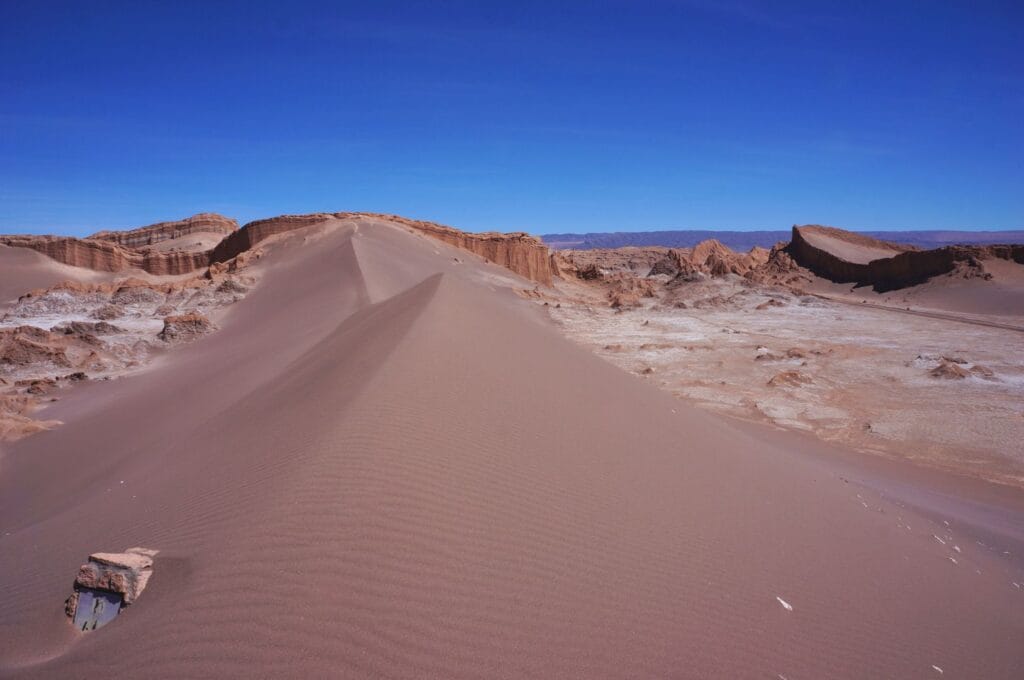
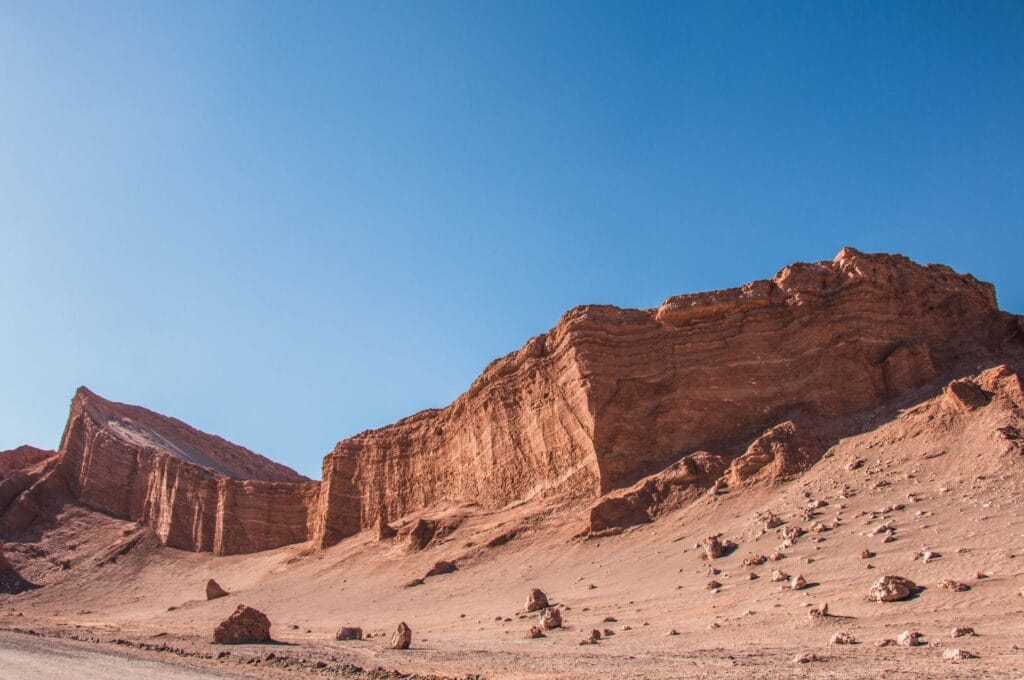
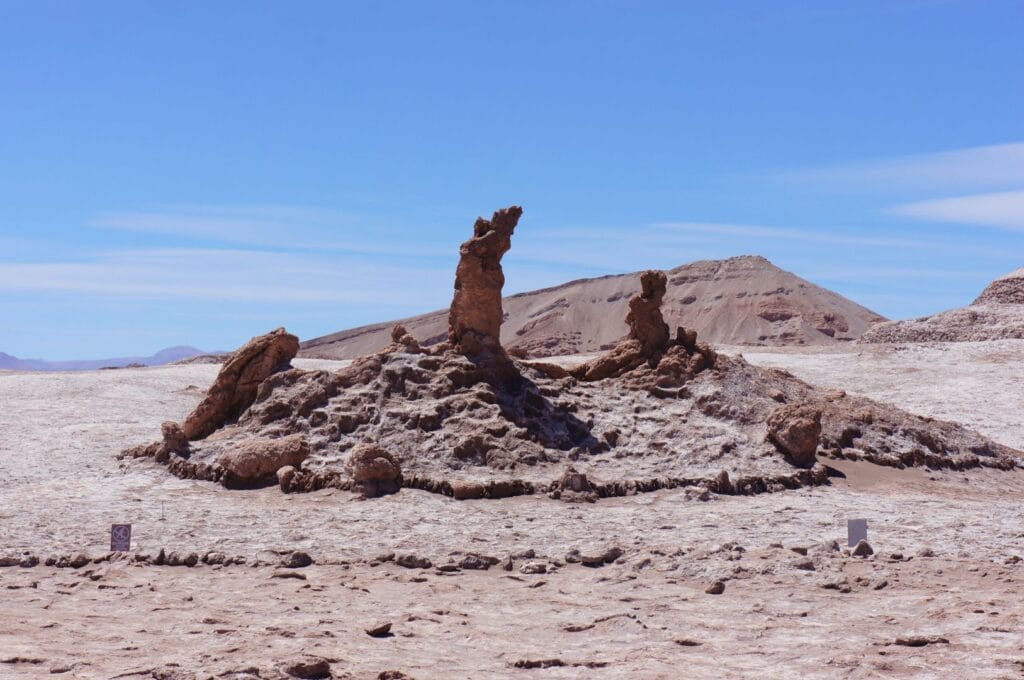
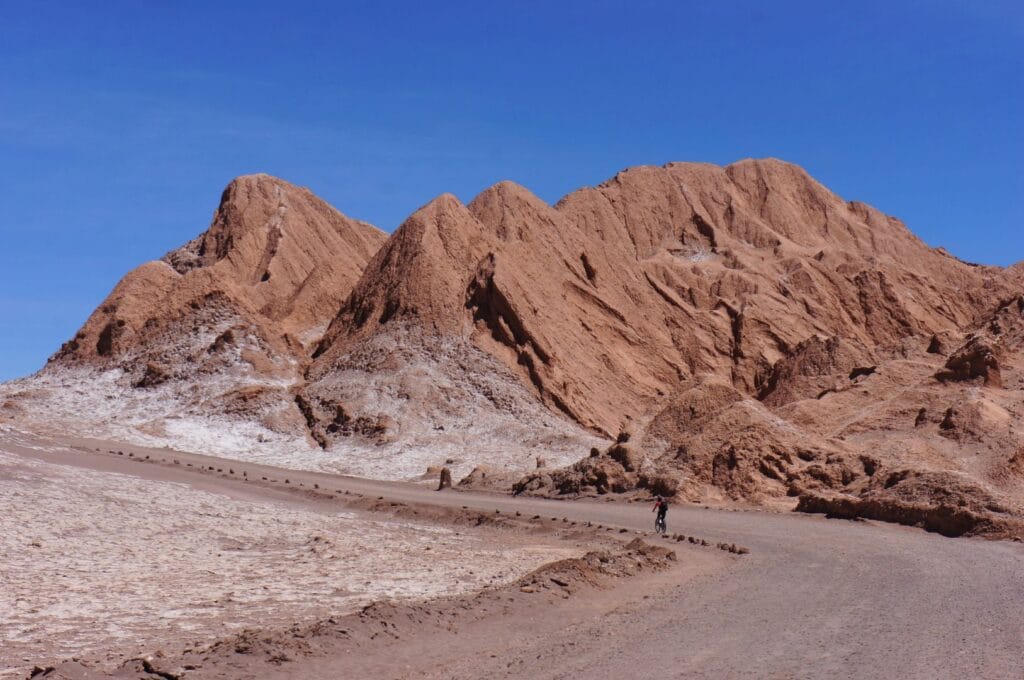
Entrance to the Valley of the Moon costs 10,800 pesos per adult and 5,400 pesos for children. You can book your tickets on the official website before arriving or purchase them directly at the entrance. As a bonus, you also gain access to the Mirador de Kari, where you can enjoy a stunning sunset over the Atacama Desert. The Valley of the Moon is open from 8:30 a.m. to 4:00 p.m. for cars, and from 8:00 a.m. to 11:00 a.m. for bicycles. Four-hour guided tours start at 3:00 p.m., allowing you to visit the Valley of the Moon and arrive just in time for the sunset. Some agencies also offer guided tours on electric bikes, a good compromise between traditional bikes and cars.
Good tip: If you arrive late in the day and still want to catch the sunset, head to the Mirador Likan-Antay. It’s free and saves you from paying the entrance fee to the Valley of the Moon.
The Valley of Death
Instead of going back the same way, we tried to reach the road to Calama to make a loop. In hindsight, we advise against this, as we ended up in the Valley of Death (Valle de la Muerte), stuck in the sand, pushing our bikes until we reached the paved road. We didn’t do it, but there’s a trail from the parking lot that follows the crest of the dune. Additionally, some agencies offer sandboarding, biking, or horseback riding in this valley, which looks like a Martian landscape!
Well, our efforts were still rewarded! We had a magnificent view of the entire valley from the Mirador de Kari!
In total, we covered 50-60 km on this first day.
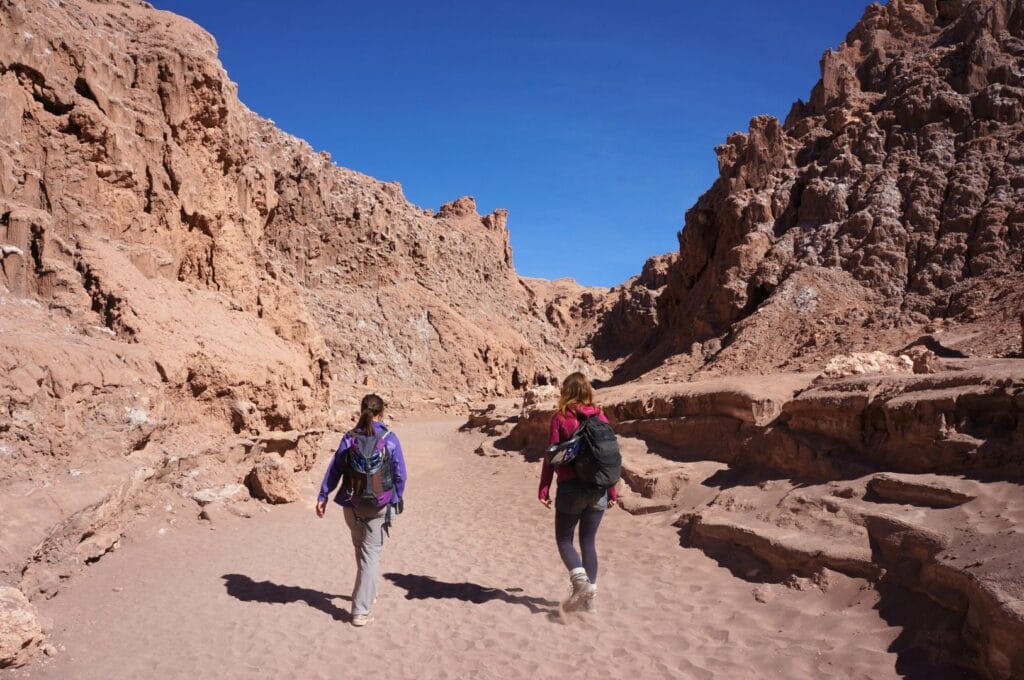
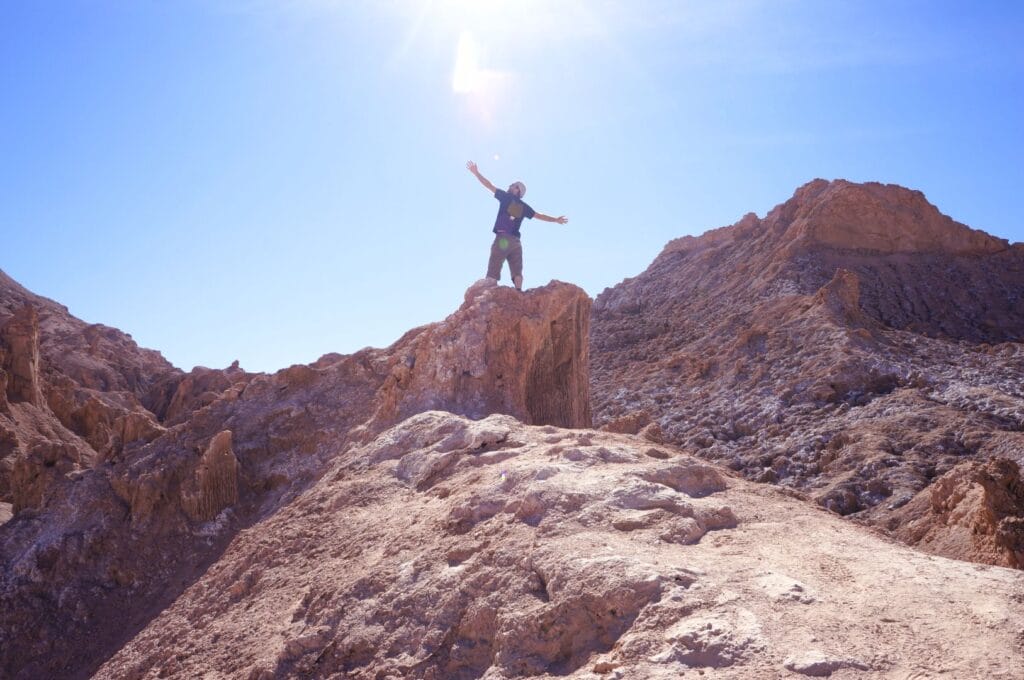
The Valley of Death is entirely separate from the Valley of the Moon. The site is accessible from 8:30 a.m. to 7:00 p.m., and the entrance fee is 6,000 Chilean pesos.
Aldea de Tulor
We didn’t visit, but Aldea de Tulor is one of the oldest archaeological sites in northern Chile. Today, threatened by erosion, this ancient village consists of round adobe dwellings connected to each other. If you’re interested in architecture and history, the entrance fee is 5,000 Chilean pesos, and a guide will accompany you during your visit. Aldea de Tulor is located 10 km southwest of San Pedro de Atacama and can be reached by car or bike. It’s open daily from 8:00 a.m. to 1:30 p.m. and from 2:30 p.m. to 6:00 p.m.
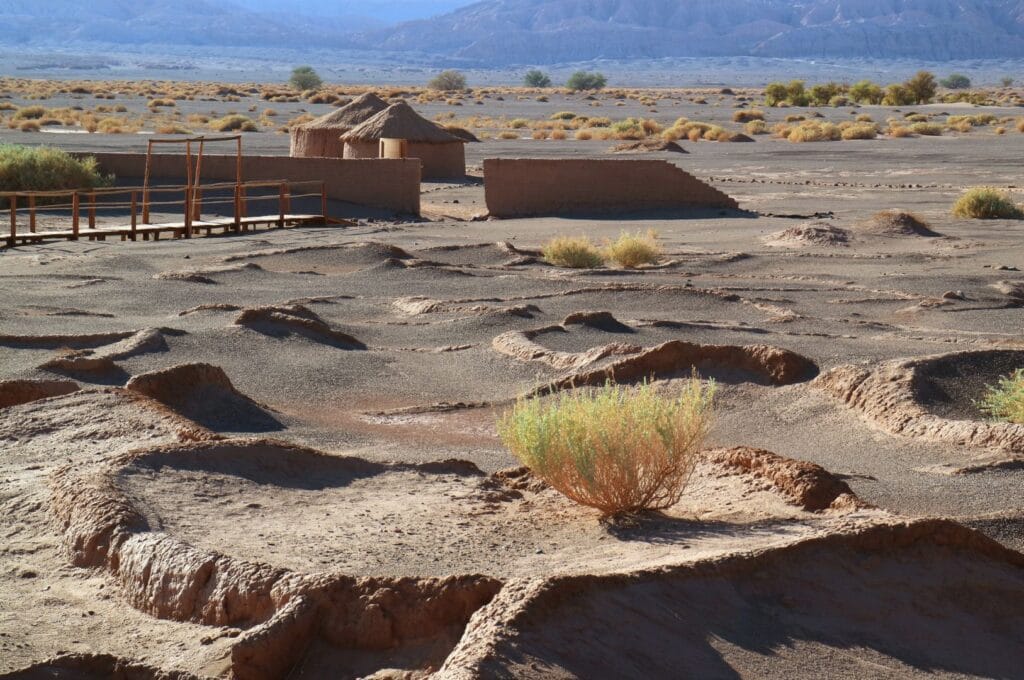
Laguna Cejar and Laguna Piedra
The next day, we continued south towards Laguna Cejar and Laguna Piedra. It’s about 15 to 20 km on a good track to reach the two lagoons.
Laguna Cejar is not open for swimming, but it’s absolutely stunning. Only the distant salt flats and a few mountains separate the horizon from the reflection of the sky in the water. Magnificent!
For swimming, head to the right-hand lagoon, Laguna Piedra. Its salt content is equivalent to that of the Dead Sea! So, you just float. A small warning, though—the water is freezing, so expect a quick dip! Only my cousin braved the water; we were a bit of wimps! If you choose to swim (for the brave ones!), there are freshwater showers available to rinse off the salt.
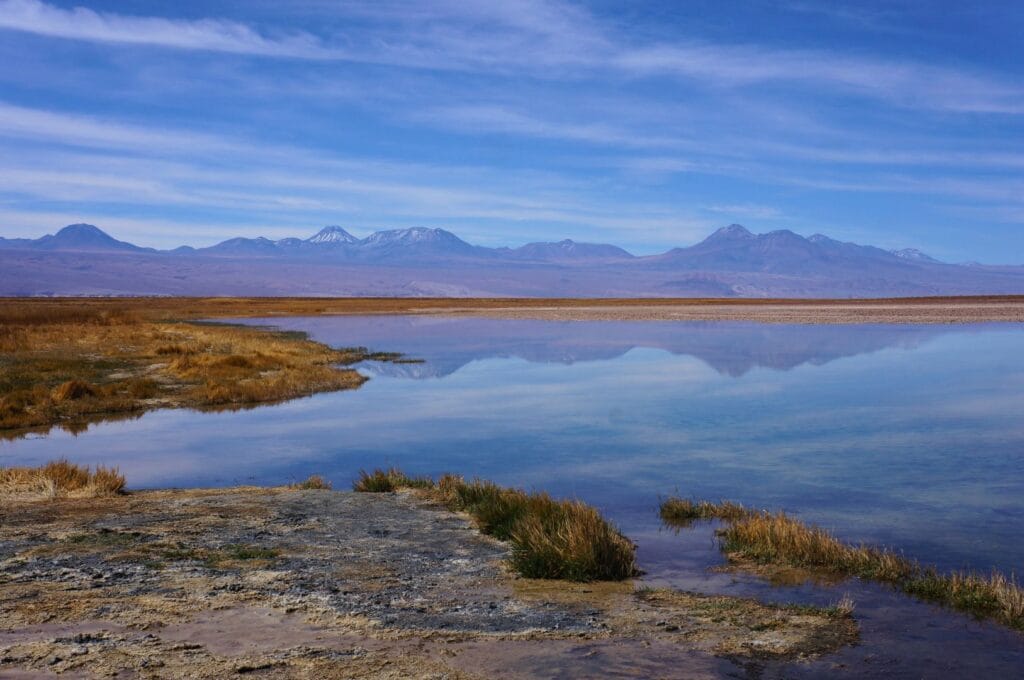
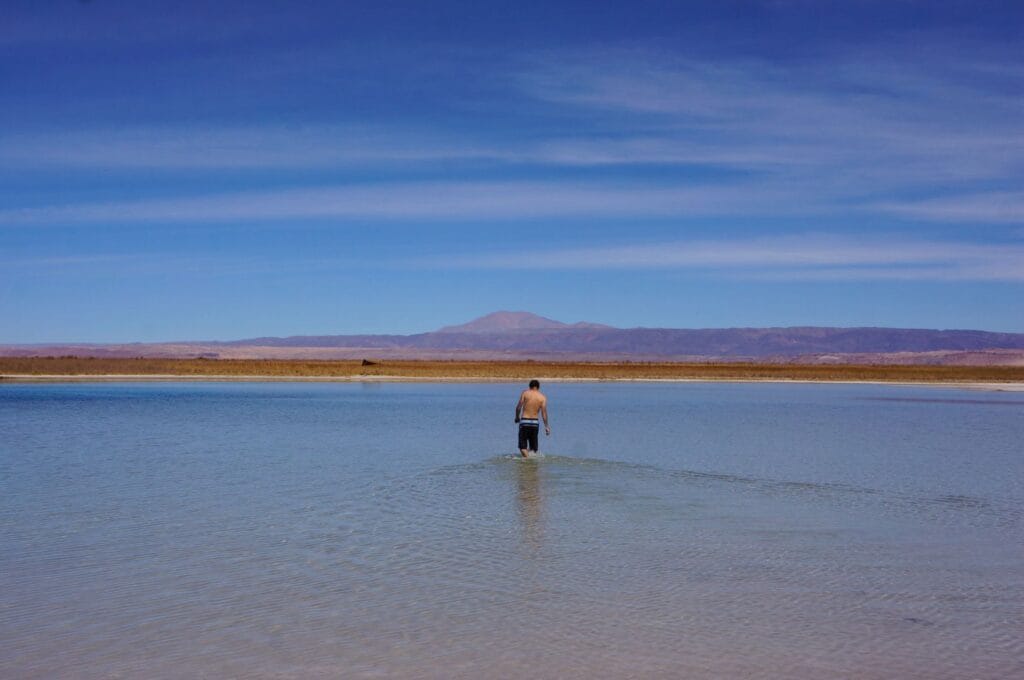
Lagunas Cejar and Piedra are open daily from 9:00 a.m. to noon, except on Tuesdays when they are closed. The ticket price is 15,000 pesos per adult and 5,000 pesos for children under 12. You must purchase your tickets before your visit or opt for a guided tour.
Los Ojos del Salar and Laguna Tebinquiche
Since we hadn’t biked enough, we continued a few more kilometers south. Our destination: other lagoons in the northern part of the Atacama salt flats, namely Los Ojos del Salar and Laguna Tebinquiche.
Unfortunately for us, the track in this direction deteriorates significantly, making it much more difficult to bike. It’s almost entirely washboard road, as cyclists say—those annoying ripples that form on the track. Very unpleasant.
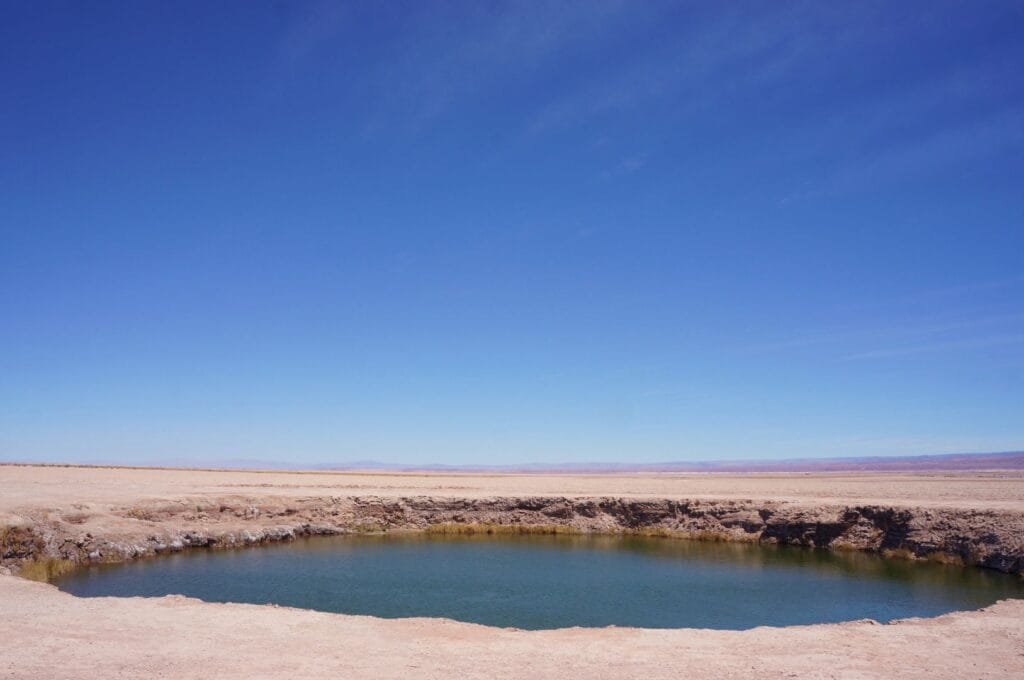
After about an hour, we arrived at two small freshwater pools that seemed to appear out of nowhere, known as Los Ojos del Salar. Tired, we decided to stop there for lunch. And since we didn’t feel like continuing to Laguna Tebinquiche on this road, we eventually turned back towards San Pedro. If you’re driving, we recommend going all the way. It’s 6 km from Los Ojos, and the landscapes are quite beautiful, with reflections of the mountains in the saline water. This is also a great spot to admire the sunset.
To top it all off, we encountered a strong headwind that covered us in the sand for the 30 kilometers back to the village. We arrived in San Pedro 3.5 hours later, full of sand and completely exhausted.
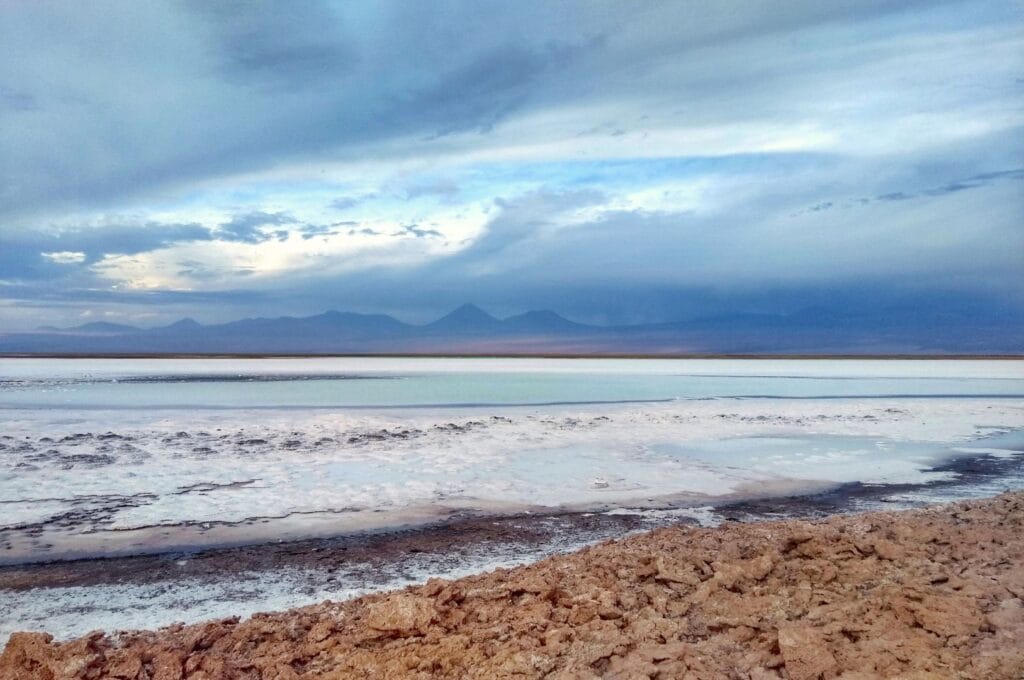
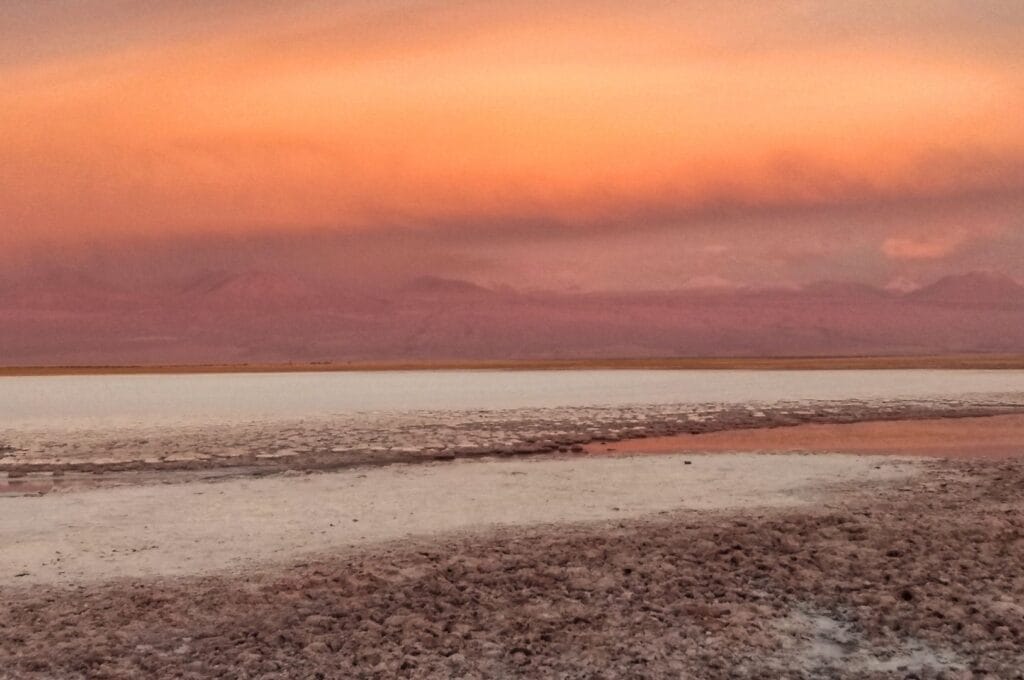
Los Ojos del Salar and Laguna Tebinquiche are open daily from 9:00 a.m. to 1:30 p.m. and from 2:30 p.m. to 5:00 p.m. The access fees are 5,000 pesos for adults and 2,000 for children under 12. You can buy tickets at the site entrance. Swimming was once allowed, so check on-site. Some guided tours combine these lagoons with Lagunas Cejar and Piedra in the afternoon, finishing the day with a sunset at Laguna Tebinquiche.
Pukará de Quitor and its mirador
As a bonus, you can visit Pukará de Quitor, a pre-Inca fortified city dating back to the 12th century, by bike or on foot. It’s located 3 kilometers northwest of San Pedro. From the parking lot, a trail will take you in 45 minutes to a magnificent viewpoint overlooking the Valley of Death. This viewpoint is also a less crowded spot to watch the sunset.
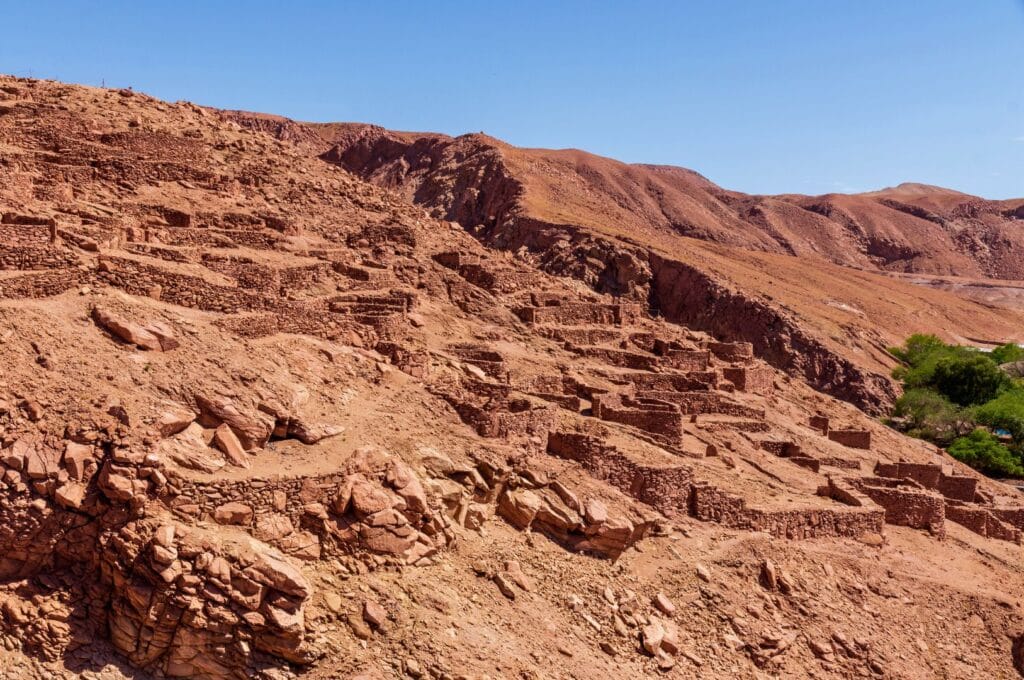
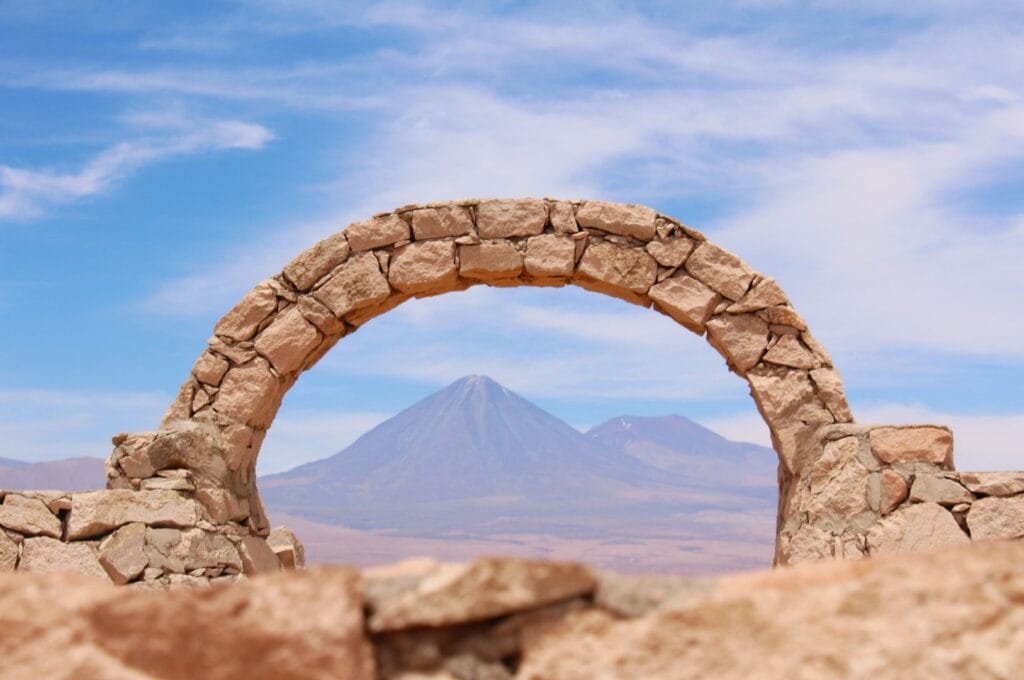
Entrance to Pukará de Quitor costs 5,750 Chilean pesos, which you can purchase directly on-site. The site is open daily from 8:00 a.m. to 4:30 p.m. (last entry, but you can stay until dusk).
Other things to do around San Pedro de Atacama
After exploring what we could by bike, we didn’t have much choice but to take a tour to see other attractions around San Pedro de Atacama. But since we couldn’t afford to do everything, we had to choose! Don’t worry—you can easily drive to the various sites; they’re just a bit farther from SPA. We’ve listed them geographically and by altitude to optimize your fuel consumption and energy.
Note: Only have three days to spend in Atacama? Make sure to see the essentials!
Visit Valle del Arcoiris and the Yerbas Buenas petroglyphs
North of San Pedro de Atacama lies the Valle del Arcoiris, literally the Rainbow Valley. If this sounds familiar, you might be thinking of the famous Rainbow Mountain in Peru. Here in Chile, it’s a series of mountains with layers of nuanced colors forming a particularly astonishing landscape. However, beware of agency photos; the saturation is often too high, and the colors are not at all representative!
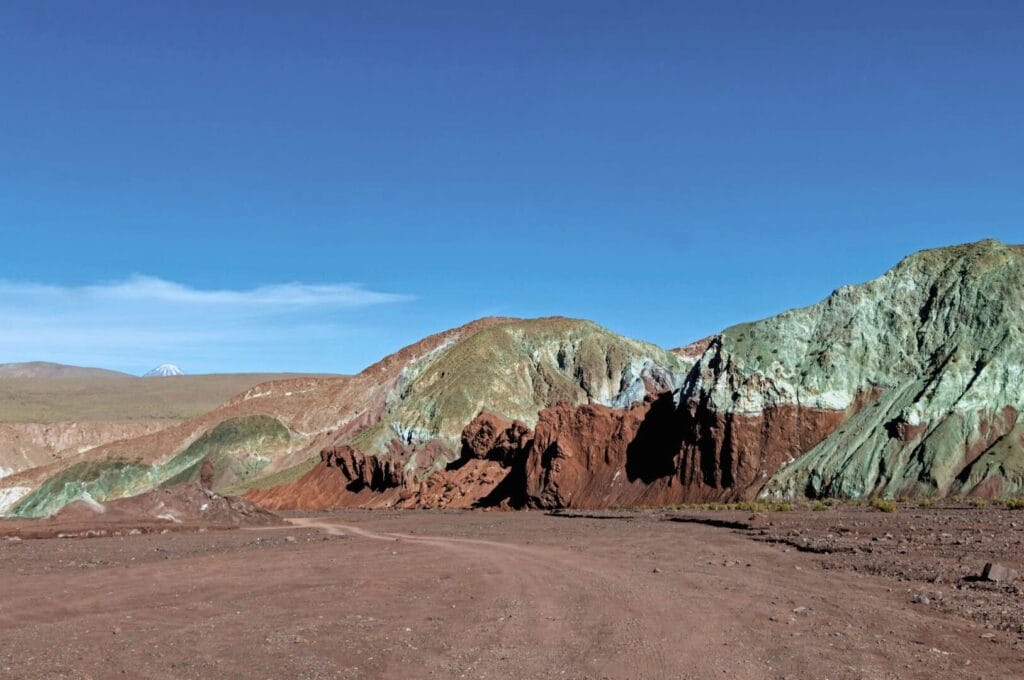
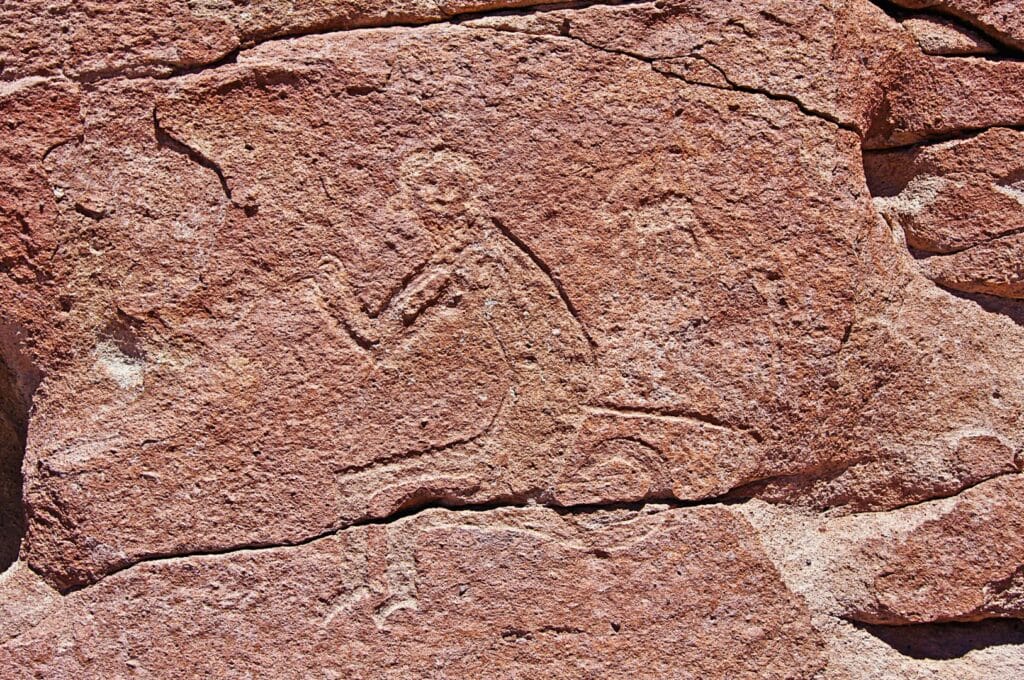
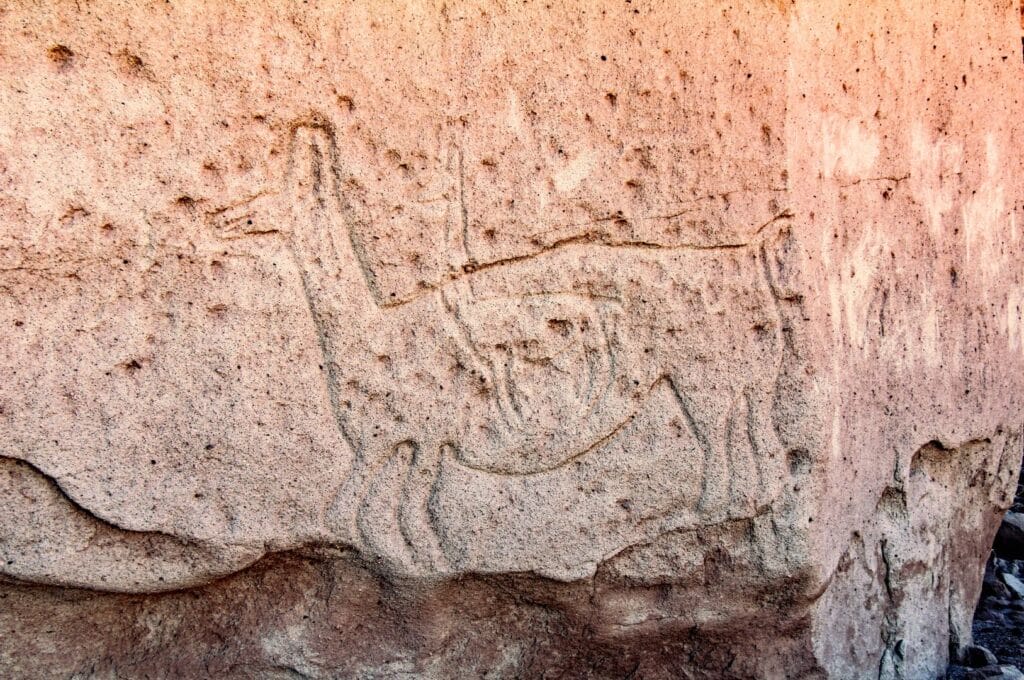
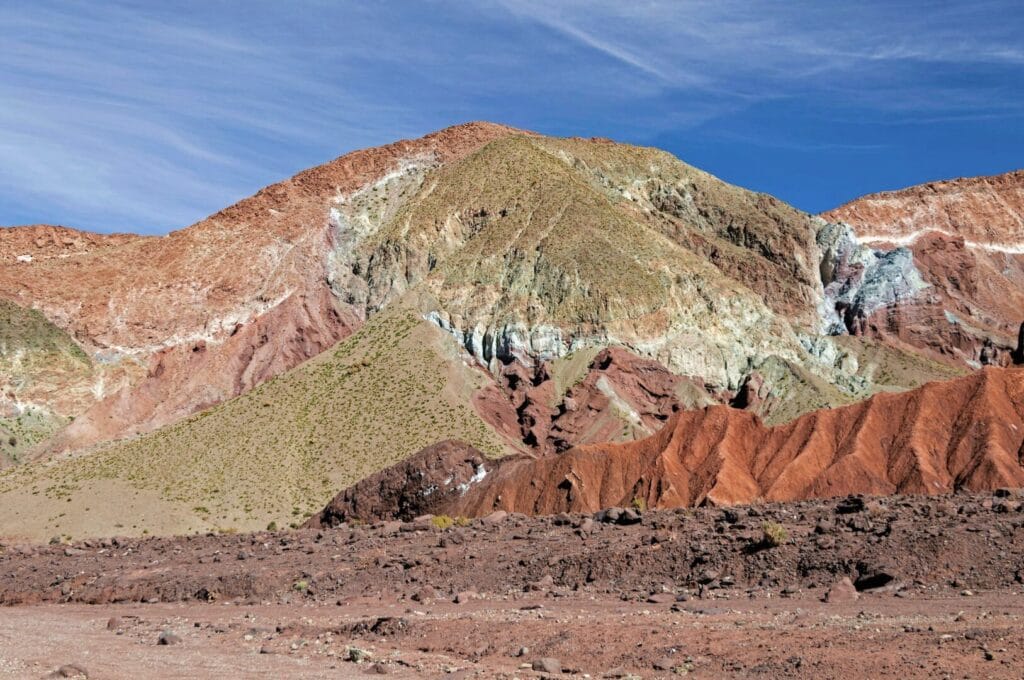
Drive to the end of the road and take a walk in the canyon. You’ll even see a kind of cave, a remnant of a waterfall. On your way back to SPA, stop at the Yerbas Buenas site, where you’ll see hundreds of petroglyphs dating back to the Inca period along the trails in the Salado River canyon.
Valle del Arcoiris and Yerbas Buenas are open daily from 9:00 a.m. to 5:00 p.m. You can purchase your entry—5,000 Chilean pesos per ticket—directly on-site or opt for a guided tour.
Discover the Atacama salt flats and Los Flamencos National Reserve
Located partly within the Atacama salt flats, Los Flamencos National Reserve is scattered southwest of San Pedro de Atacama. It’s full of natural gems where you’ll have the chance to see many pink flamingos! The entire national reserve can be explored by car or through guided tours. We particularly recommend this one for its excellent value for money. Plus, tickets, breakfast, and lunch are included.
Each site within Los Flamencos has its specific pricing and hours of operation.
Laguna Chaxa
Laguna Chaxa is one of the places where you can observe different species of flamingos in a breathtaking setting! If you can, go early in the day before the tourist buses arrive and scare away the birds, or visit at sunset—it’s simply magical!
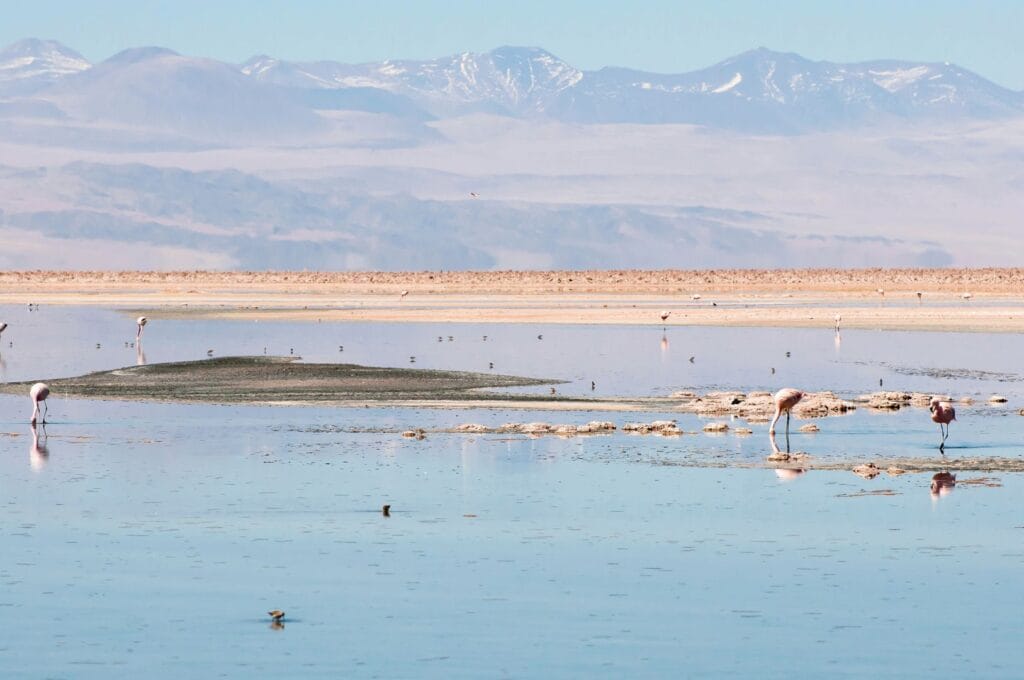
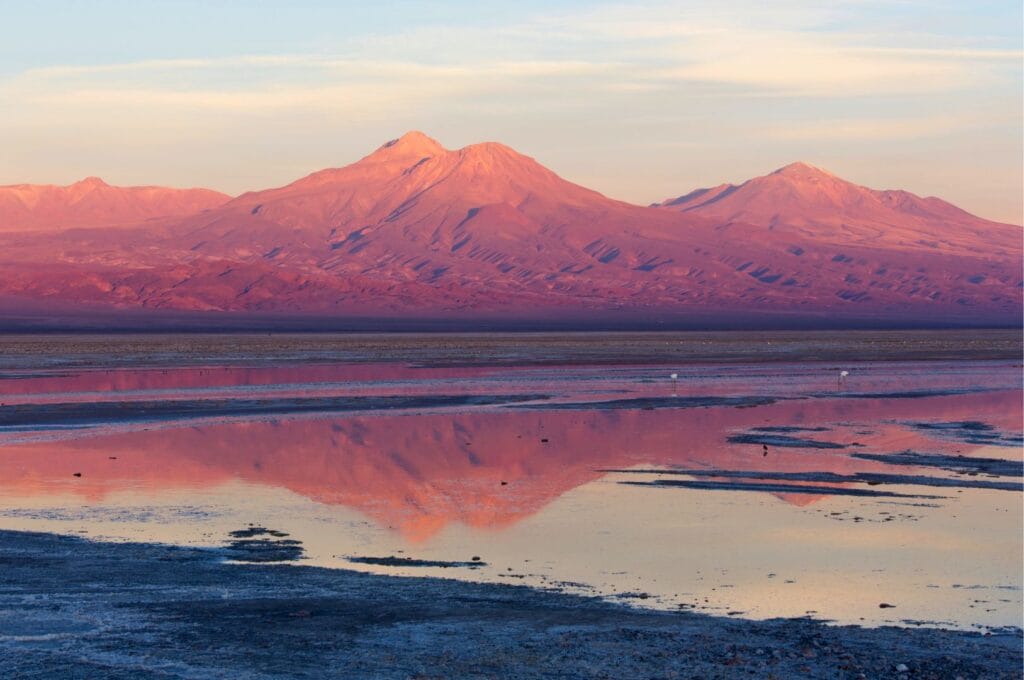
Laguna Chaxa is accessible daily from 7:00 a.m. to 6:00 p.m. The ticket price is 12,000 Chilean pesos for adults and 8,000 for children. Be sure to book your ticket in advance on the official website (search for “chaxa”). The only available time slot is at 7:00 a.m., but you can arrive anytime during the opening hours. The tour of Laguna Chaxa takes 45 minutes.
Lagunas Miscanti y Miñiques or Lagunas Altiplanicas
We had already seen a lot of lagoons and flamingos in Uyuni. But if these magical landscapes appeal to you, then an excursion to the blue lagoons of Miscanti and Miñiques, surrounded by snow-capped peaks, is perfect for you. The site is located in Los Flamencos National Reserve, 1.5 hours south of San Pedro de Atacama.
Note: The Lagunas Miscanti and Miñiques are situated at over 4,000 meters above sea level. So, it’s better to visit them towards the end of your Atacama stay, especially if you’re not accustomed to high altitudes.
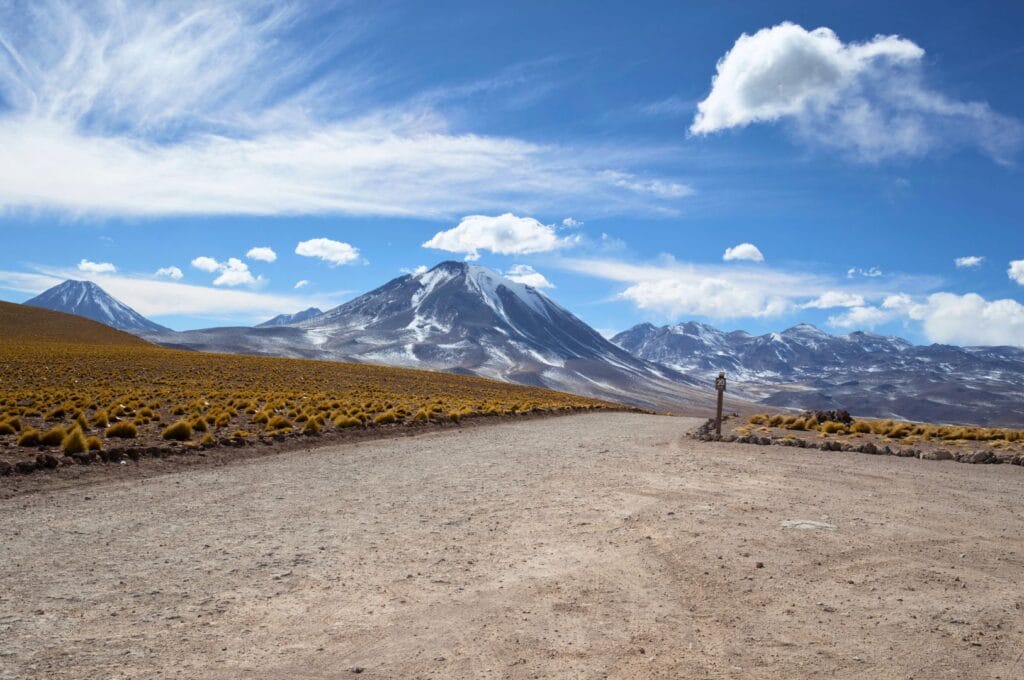
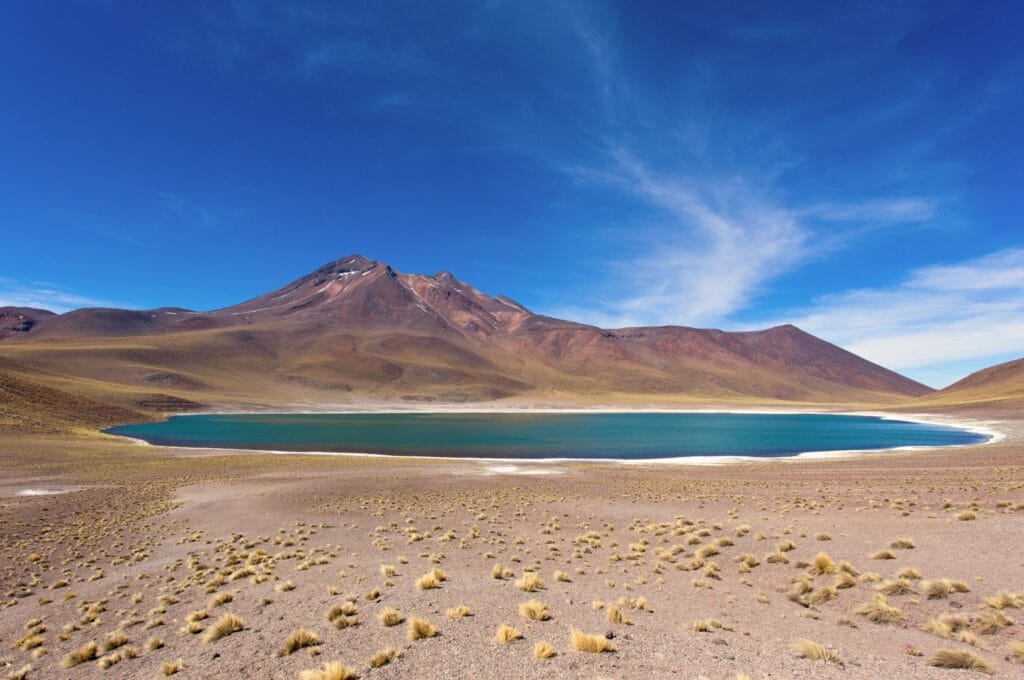
To enter the Lagunas Altiplanicas, you must book your tickets online and present yourself one hour before the scheduled time at the control office located at the entrance of the village of Socaire, 10 km north of the lagoons. So, if you’ve booked the 9:00 a.m. slot, you need to arrive at 8:00 a.m. at the Socaire office to have your reservation checked. The entrance ticket costs 10,000 Chilean pesos per adult and 8,000 for children.
Stop at the Tropic of Capricorn
OK, it’s more of a stop than an activity! If you’re a fan of signs and geographical curiosities, this symbolic point is for you! The Tropic of Capricorn passes through the Atacama Desert, south of SPA, between Toconao and Socaire. Take a break here on your way to the Miscanti y Miñiques lagoons.
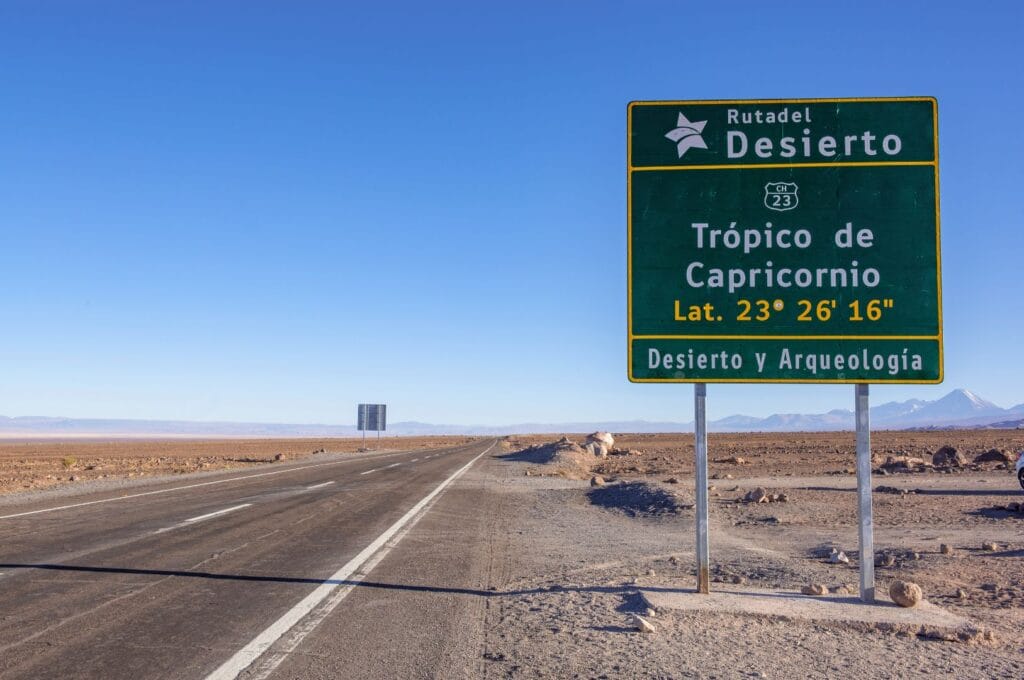
Visit Salar de Talar, Piedras Rojas and Laguna Tuyalto viewpoint
From the Altiplanic Lagoons, continue 50 km south on Route 23 to discover Piedras Rojas, a truly remarkable site with red hues along the Aguas Calientes salt flats (also known as the Salar de Talar). To reach the lagoon of these salt flats, take the 2 km path.
Just nearby, 9 km east and not far from the Argentine border, visit the viewpoint of Laguna Tuyalto. Overlooked in favor of Piedras Rojas, it still offers a stunning panorama of the lagoon.
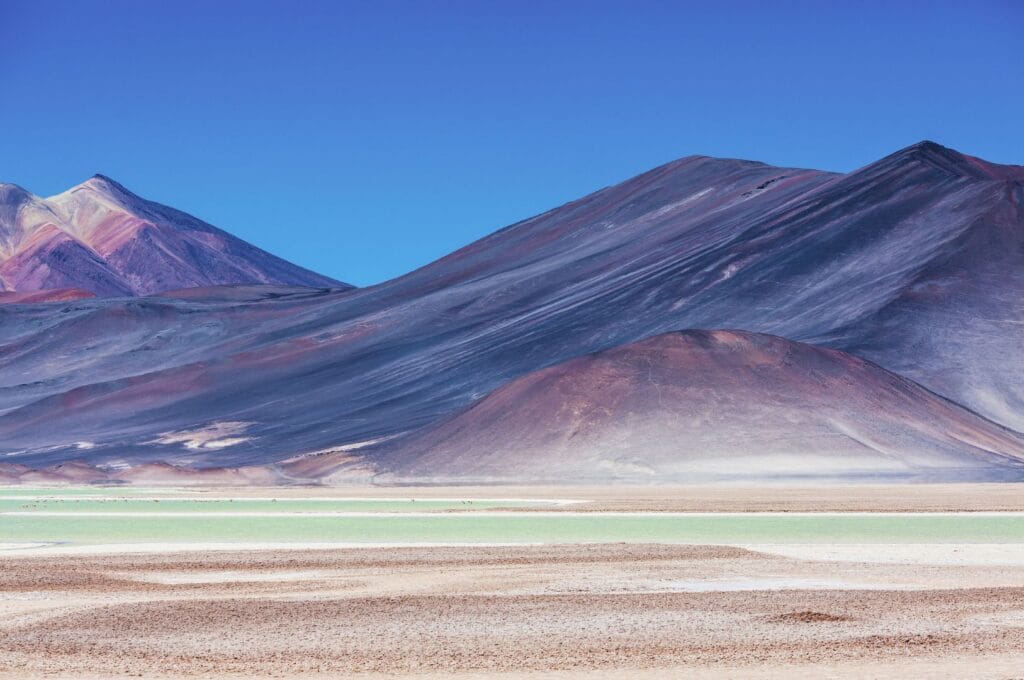
Just like with the Lagunas Altiplanicas, you must purchase your entry ticket online and present yourself at the Socaire office 1 hour before your time slot. The ticket for Piedras Rojas also costs 10,000 pesos for adults (8,000 for children), but you can buy a combined ticket for the Altiplanic Lagoons and Piedras Rojas for 15,000 Chilean pesos per adult (13,000 per child). The tour of these two sites lasts about 2-3 hours. Good news: the viewpoint at Laguna Tuyajto is free 😉.
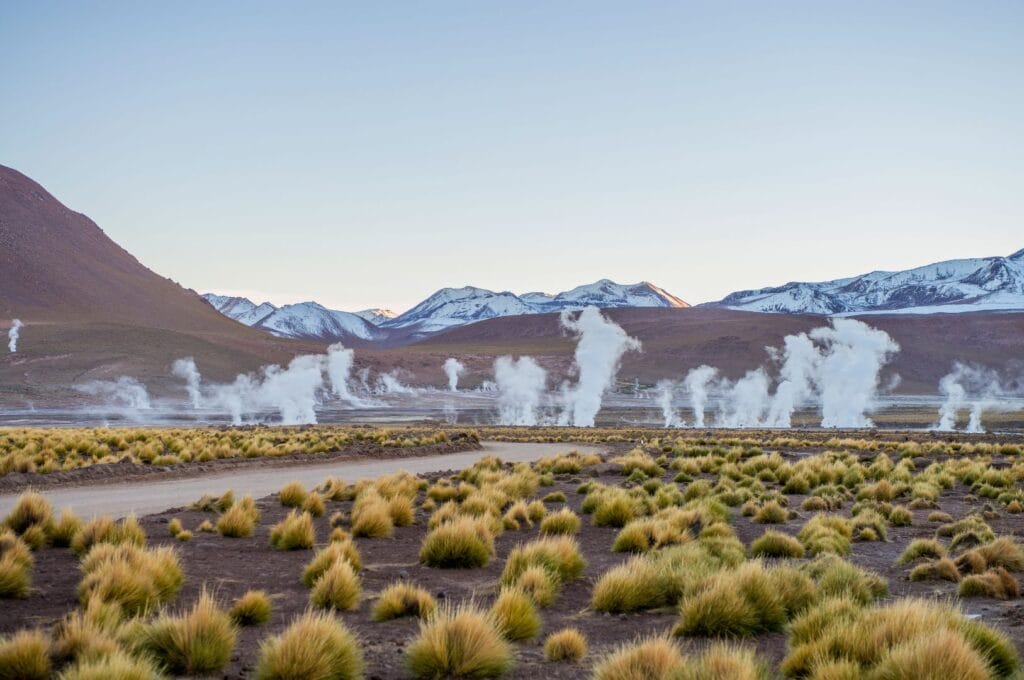
Observe the El Tatio Geysers
We had already seen quite a few lagoons, flamingos, and volcanoes in the Uyuni salt flats and Sud Lípez. So, we decided to visit the El Tatio Geysers, located about 100 km north of San Pedro de Atacama at over 4,000 meters in altitude. With its 80 smoking geysers, it’s the largest geyser field in South America! Here, there’s no possibility of getting there by bike. So we opted for this half-day tour with a 4:30 a.m. departure and breakfast included.
So, why get up so early to see geysers? It seems that our geyser friends are more active when the outside temperature is cooler. Therefore, the best time to observe them is at sunrise.
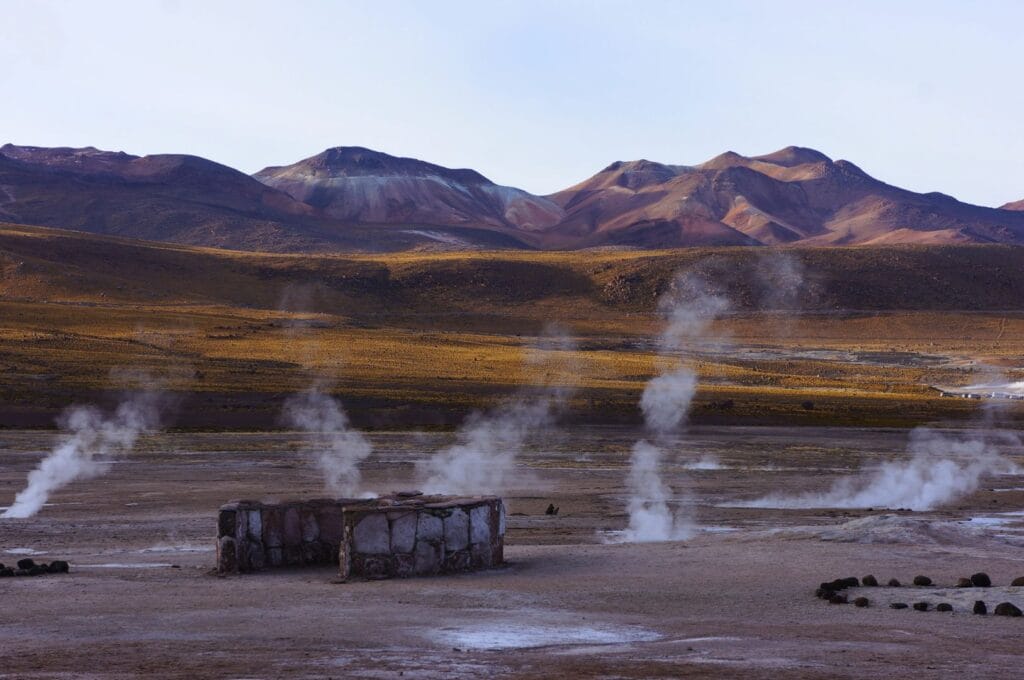
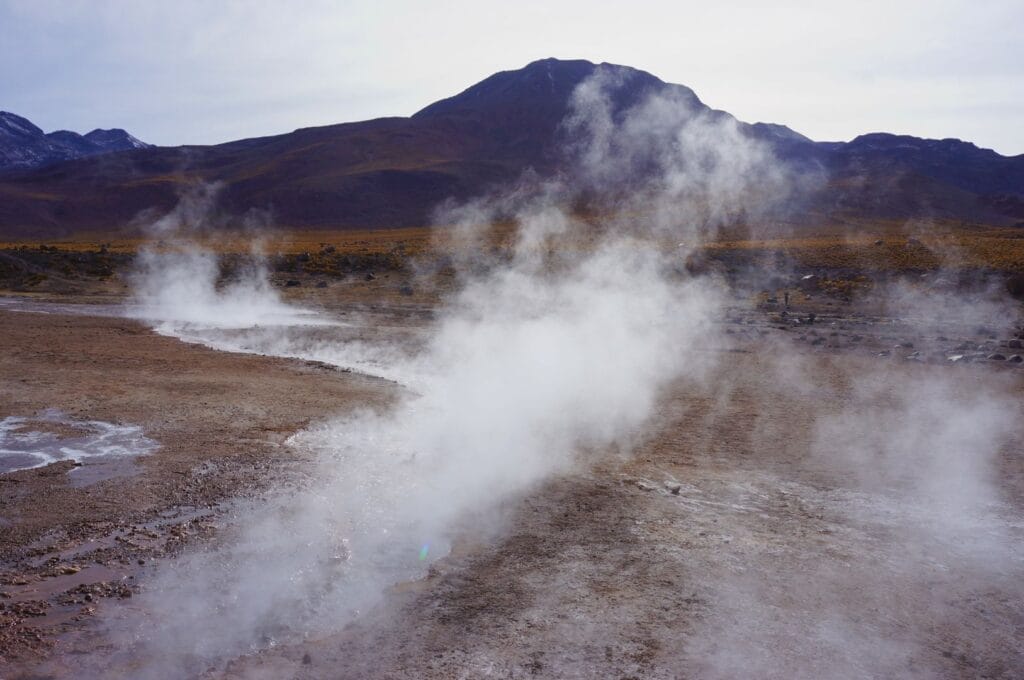
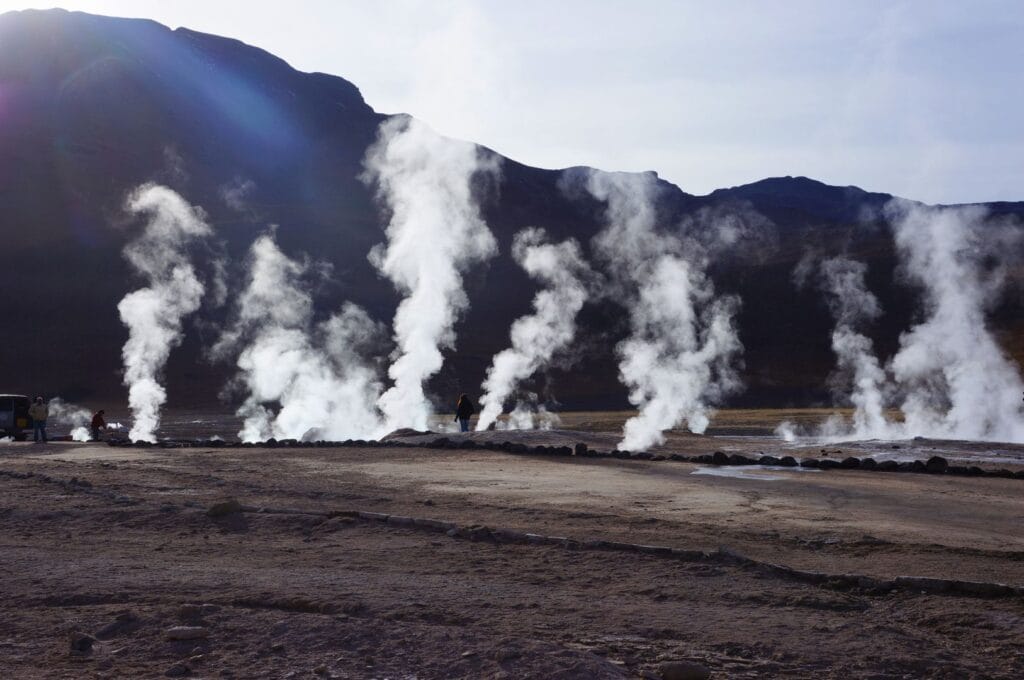
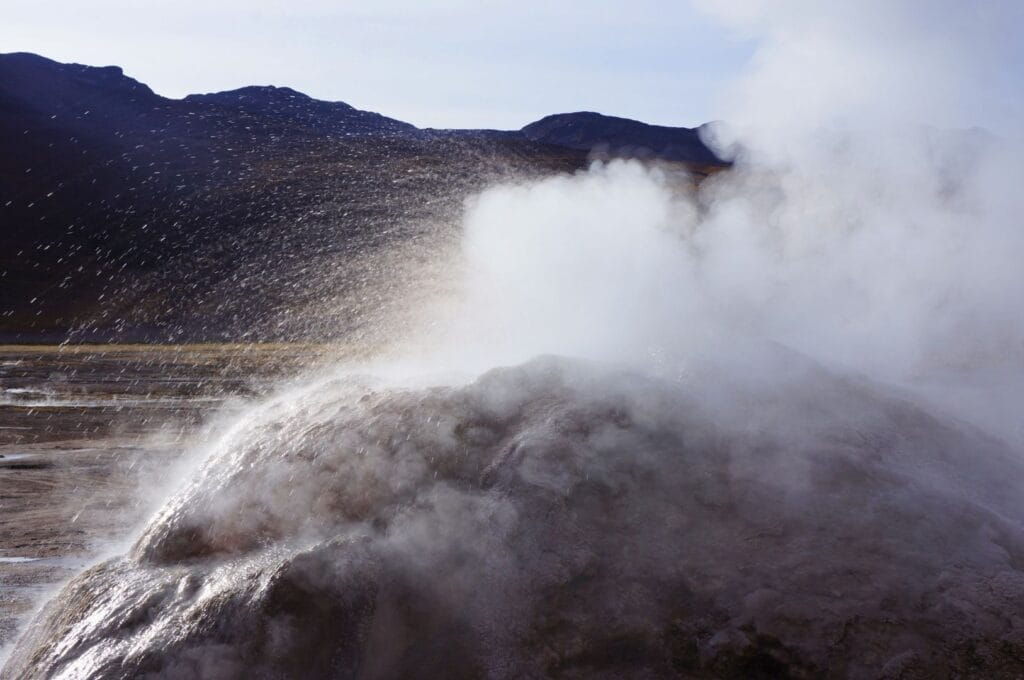
As planned, we were up and ready at 4:30 a.m. in front of the hotel. But, as often happens with these buses that pick up tourists, we were almost the last ones to be picked up at 5:15 a.m. Grrrr! Well, we settled into our seats while the bus finished its rounds. Then, our guide informed us that we would have about a 1.5-hour journey and that we could go back to sleep. We promptly did so!
Given the delay, we were a bit worried that we might miss the show! Although we were among the last to arrive at the El Tatio geyser field, we still got to enjoy our geyser friends in full activity! However, we wouldn’t have wanted to arrive half an hour later.
Now, don’t expect 20-meter-high water jets, but the number of geysers and the steam rising from them make the overall view quite impressive! Additionally, our guide of the day provided us with lots of interesting information, which enhanced the visit.
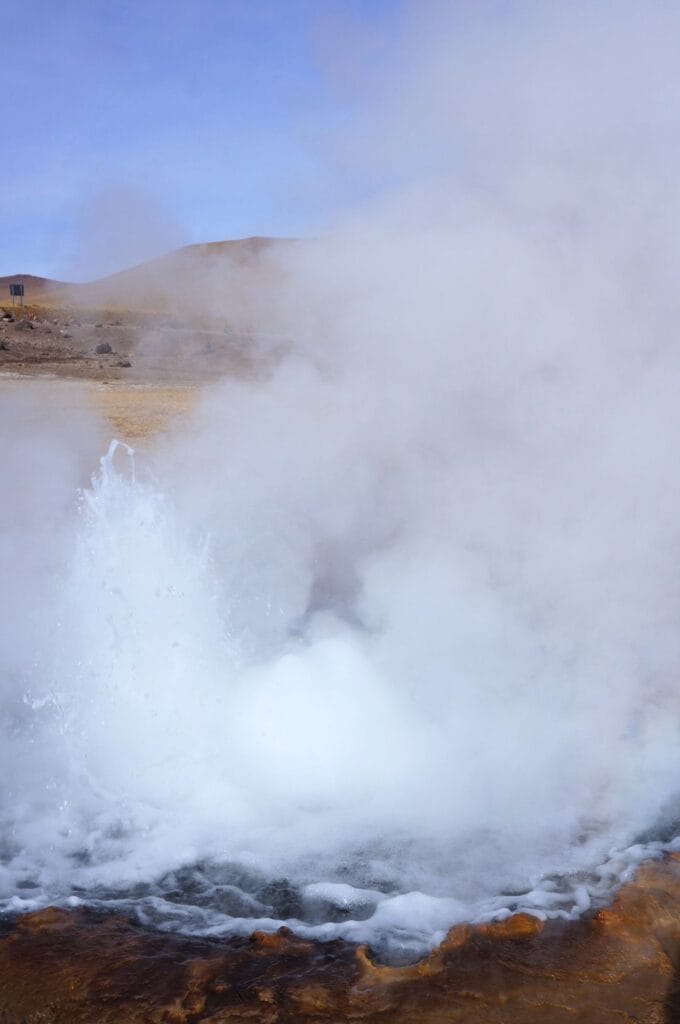
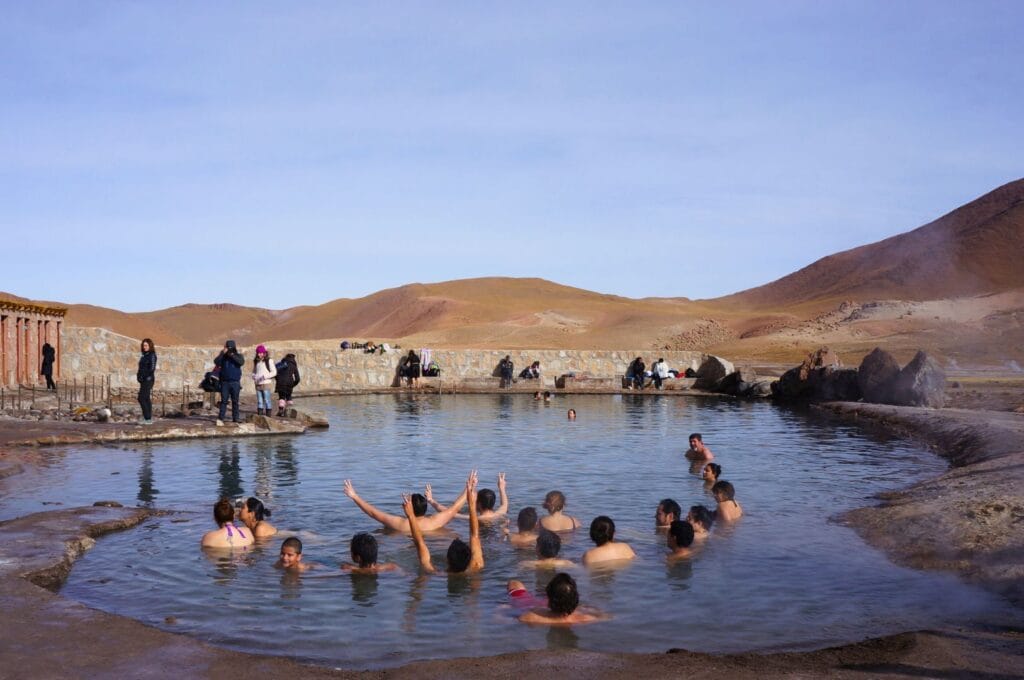

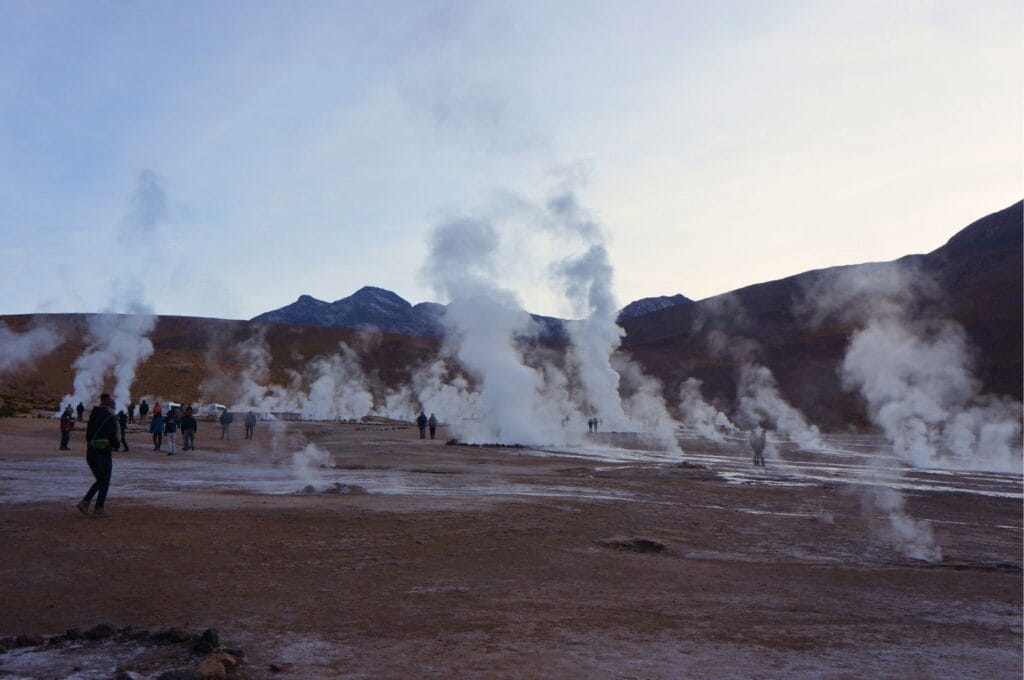
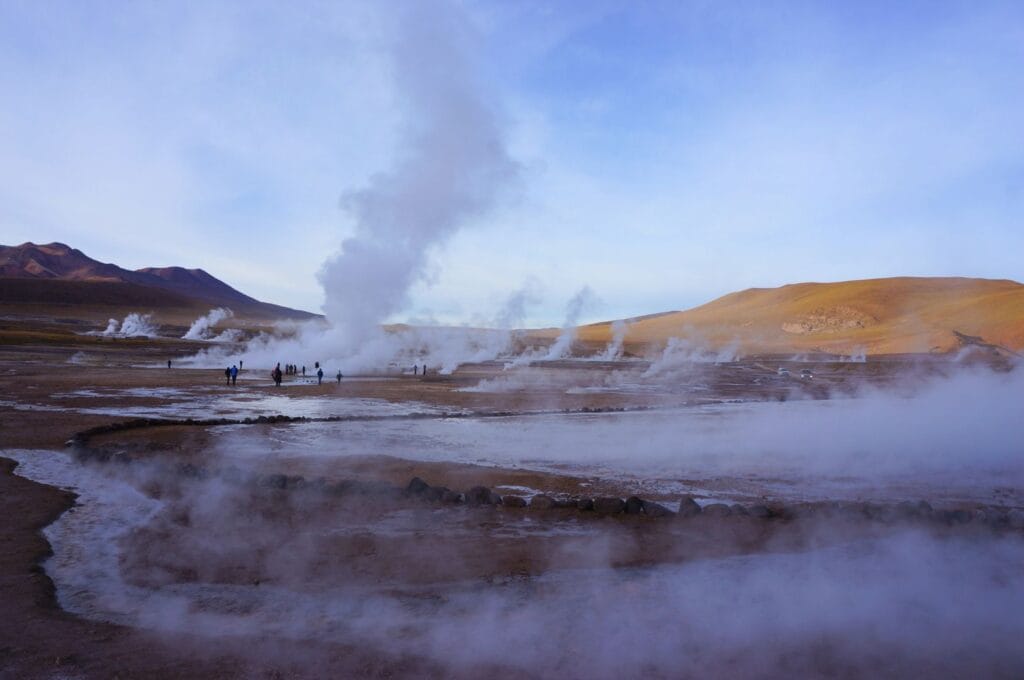
Entry to the El Tatio Geysers costs 15,000 pesos per person, and it’s free for children under 8 years old. The site is open from 6:00 a.m. to 4:00 p.m.. During our guided tour, we were treated to a champion’s breakfast in the middle of the geysers. For once, there was more than enough food for everyone! Tea, coffee, hot chocolate, bread, jam, cakes, biscuits… Perfect!
Bring very warm clothes with you! It was still -10 degrees Celsius when we arrived at the El Tatio Geysers around 7:00 a.m. Don’t forget to bring your swimsuit if you want to bathe in the hot springs. We skipped this to have more time among the geysers, but it looked fun.
If you want to visit the site away from the crowds, plan your visit after 9:00 a.m. The geysers will be less active, but the tourists will have left!
Note: since the geysers are located at over 4,200 meters in altitude, save this stop for the end of your itinerary!
Stop at the Putana viewpoint and visit the small village of Machuca
If you have your own car to explore Atacama, stop at the Putana viewpoint on your way back from the El Tatio Geysers for an incredible panorama around the Rio Putana.
Further on, take a break in Machuca, an Andean indigenous village with houses made of adobe walls. Its unique church is worth a visit, as are its empanadas or llama skewers. A treat for food lovers!
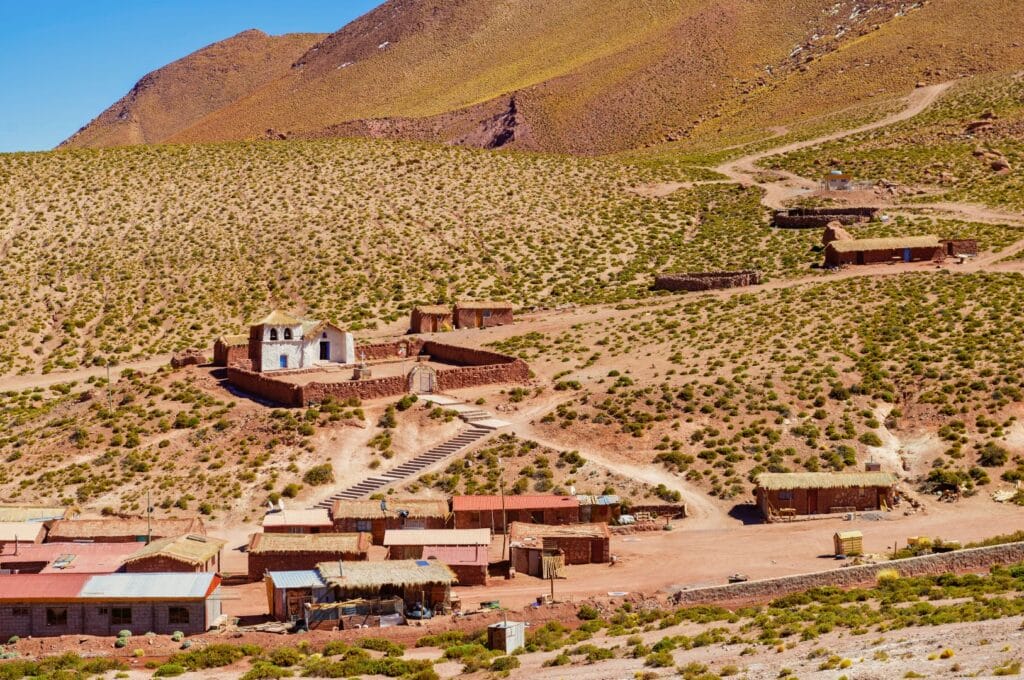
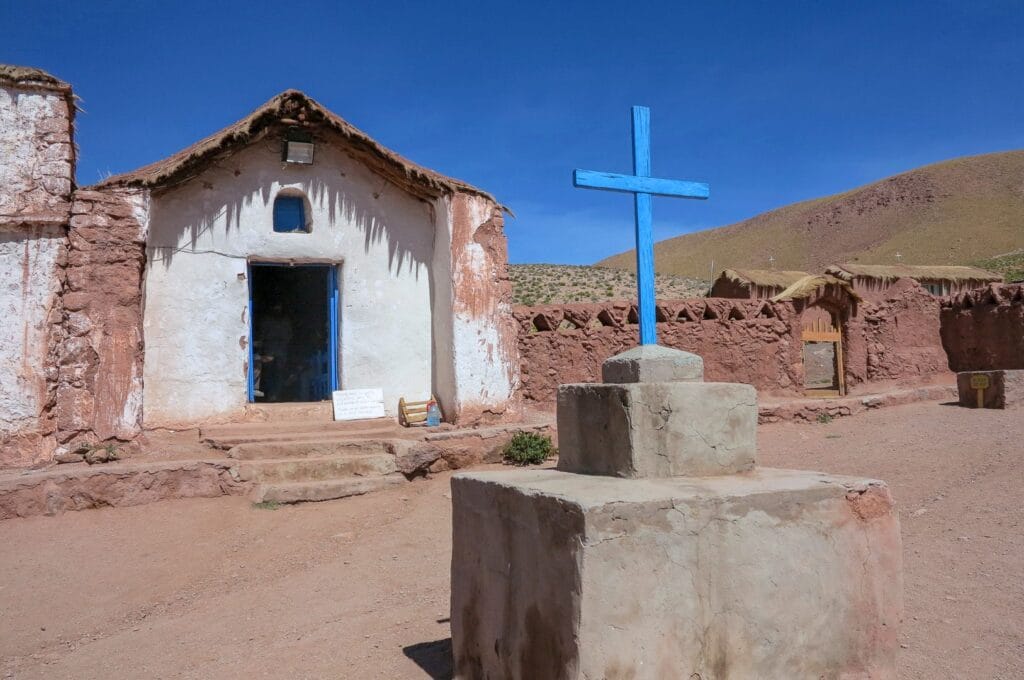
Bathe in the Puritama hot springs
If you skipped the hot springs at the El Tatio Geysers, don’t miss the Puritama hot springs. Here, in this natural reserve, you can bathe in the Puritama River, which has a temperature between 26 and 33°C depending on the pools. In short, you won’t hesitate to take a dip when it’s cold!
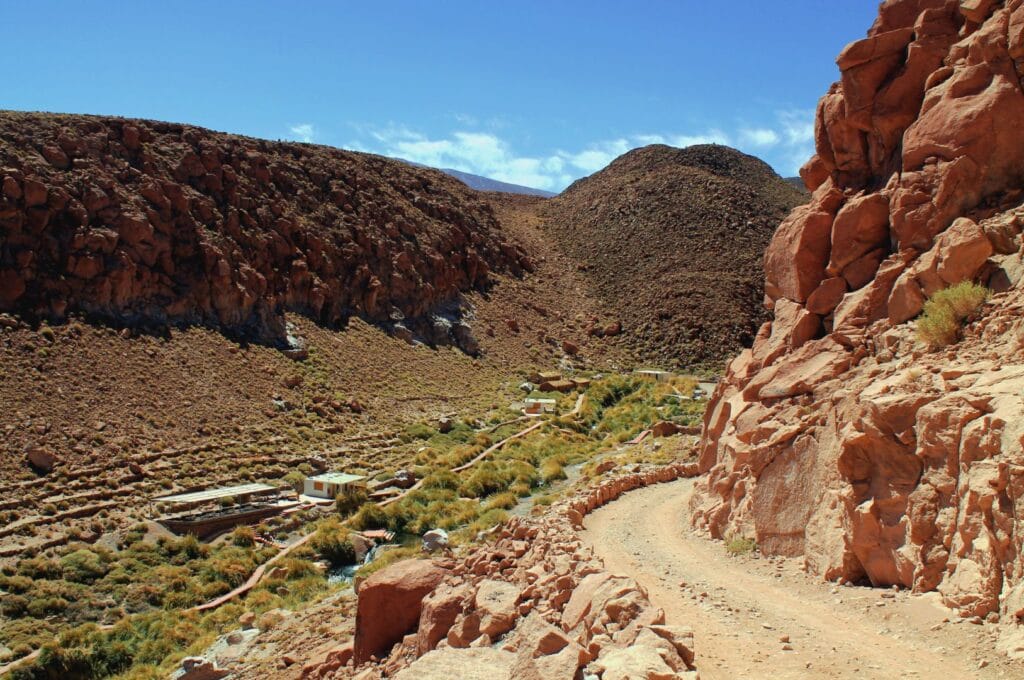
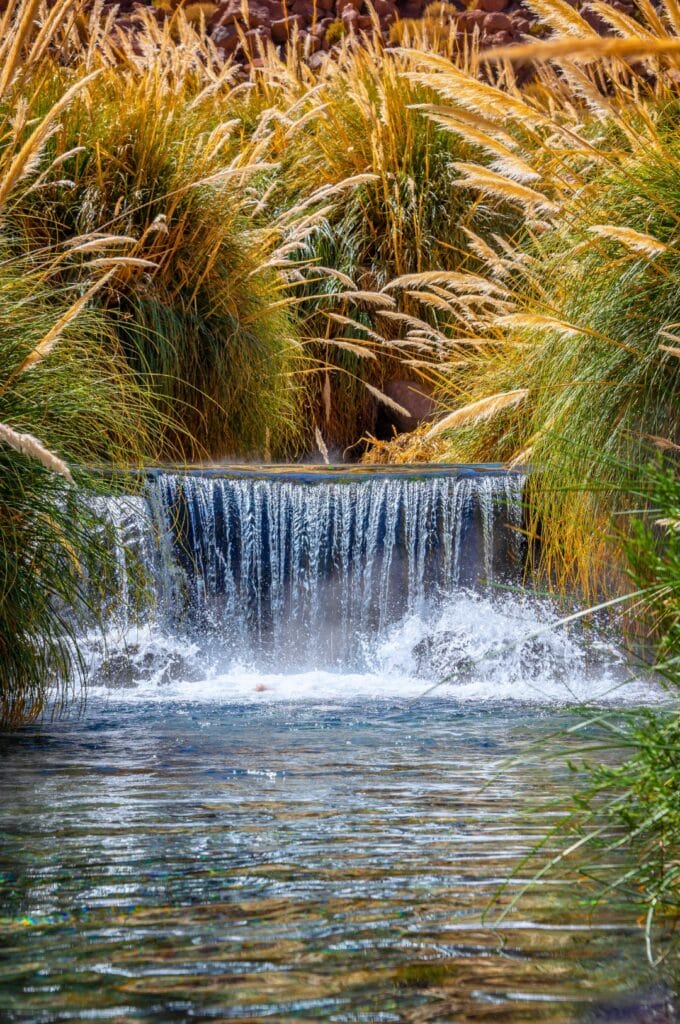
Entry to the Termas de Puritama costs 35,000 Chilean pesos. Be aware that you must buy your ticket online and book your time slot: in the morning from 9:30 a.m. to 1:30 p.m., or in the afternoon from 2:30 p.m. to 6:00 p.m. If there are no more spots available, you have two options: take a guided tour from Atacama or park at this point to take a short hike up the Puritama River. You’ll reach small pools surrounded by small waterfalls where you can bathe in the hot water, upstream from the hot springs.
Walk through the Guatín Canyon or the Cactus Valley
On your way back from the hot springs, stop at the Guatín Canyon, where you’ll discover a plethora of giant cacti in the canyon. You can take a short hike and even bathe in the warm current of the Rio Vilama; some spots are deep enough to immerse yourself. And a positive note: entry to the Guatín Canyon is free!
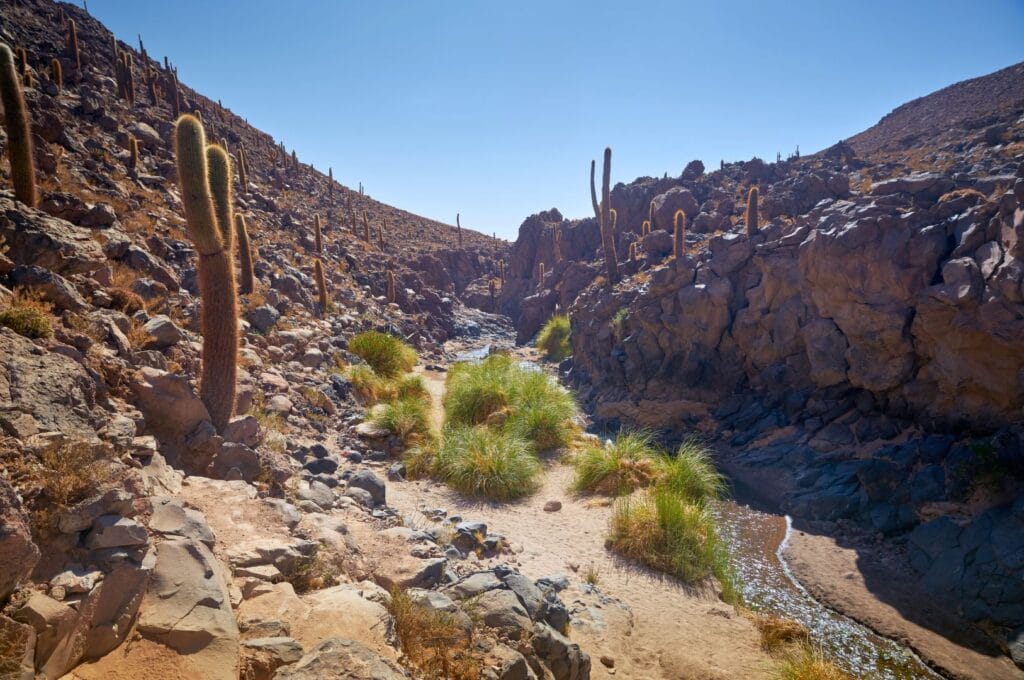
Go to Lagunas Escondidas de Baltinache
The Lagunas Escondidas de Baltinache were once a great place to swim and float, just like Laguna Piedra near Laguna Cejar. Now, you can only walk around them on a 2 km loop trail. Nevertheless, these lagoons are beautiful with their turquoise water but don’t make the trip just for them.
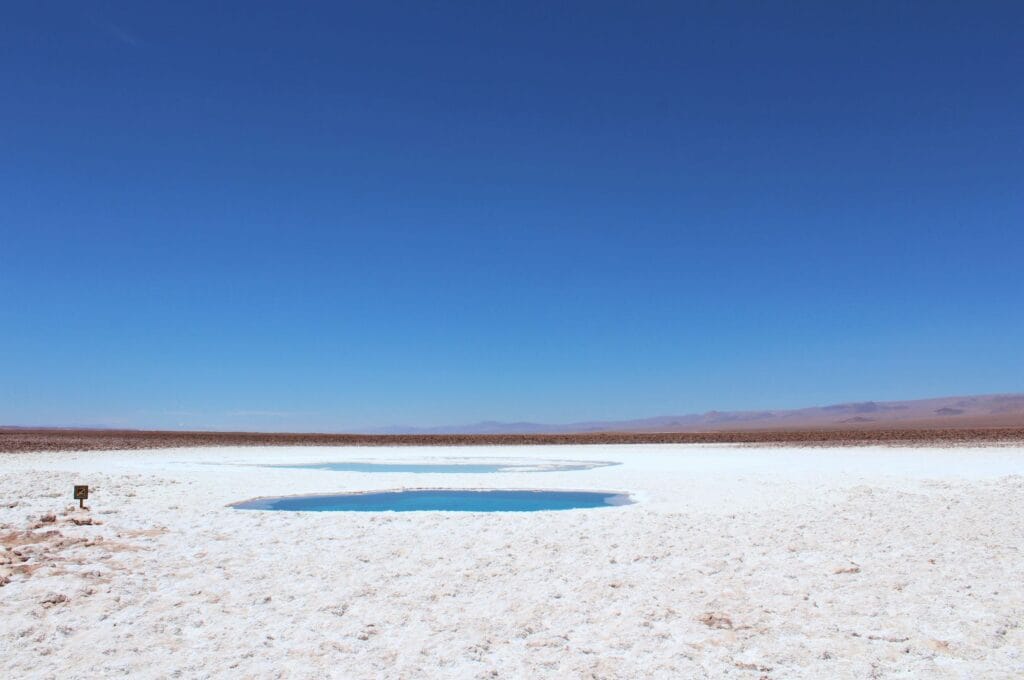
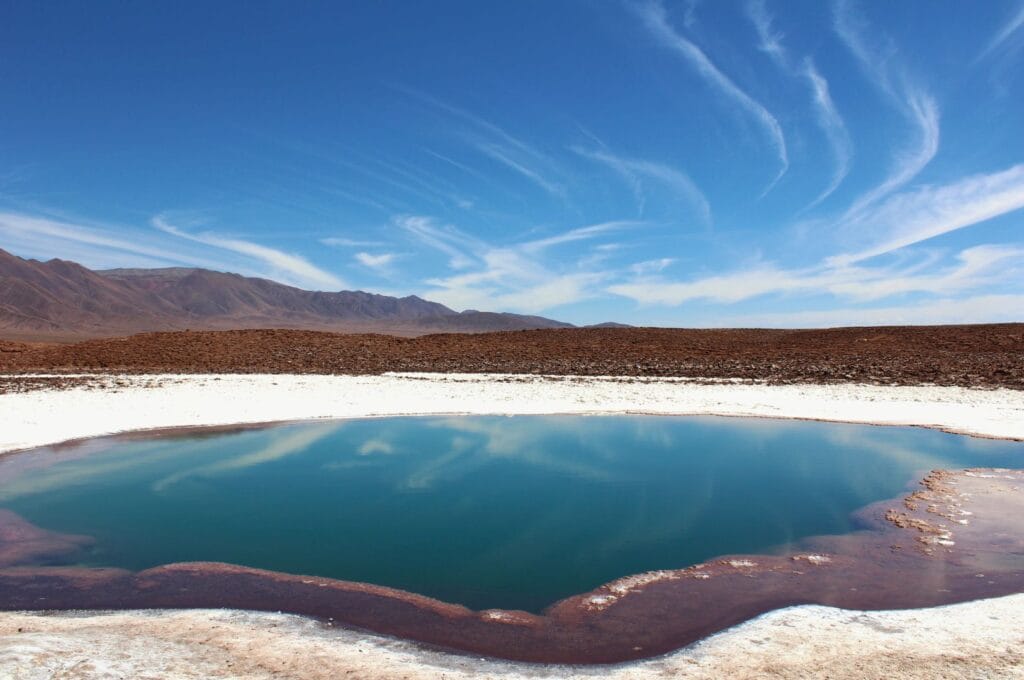
The Escondidas de Baltinache Lagoons are located 1-hour southwest of San Pedro de Atacama. You can buy tickets on-site for 5,000 Chilean pesos per adult. The lagoons are open daily from 9:00 a.m. to 1:30 p.m. and from 2:30 p.m. to 5:30 p.m. Swimming is now prohibited.
Wander through strange rock formations
East of San Pedro de Atacama, the Monjes de La Pacana site is somewhat strange… Due to erosion, the rocks have taken on shapes that form these peculiar natural sculptures. It’s free, and part of the route can be done by car. The road leading there is ultra-scenic. Make a stop at the Quebrada Quepiaco viewpoint, then feel free to continue further to reach the Tara Salt Flat.
Note: this very complete tour takes you east of the Atacama Desert, a zone often deserted by tourists.
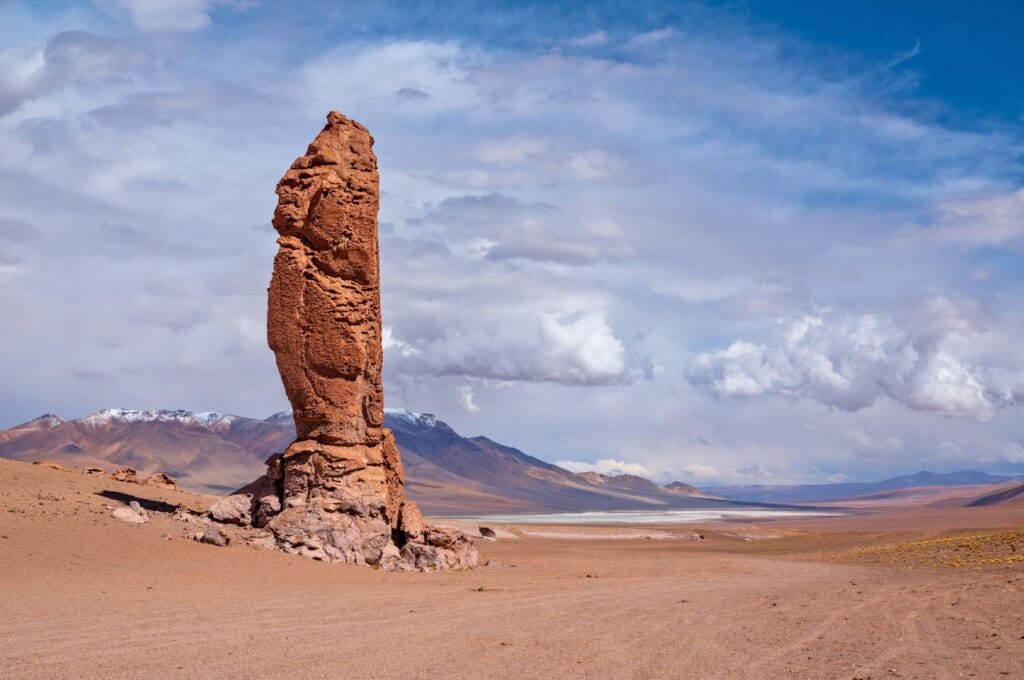
Getting closer to Argentina at the Salar de Tara
Even further east, 8 km from Monjes de La Pacana, Laguna Aguas Calientes I (and its Pacana Caldera viewpoint) as well as the Salar de Tara are located near the Argentine border, in the most remote part of the Los Flamencos National Reserve. From what we’ve heard, the landscapes are stunning, and few people go there. We think it’s one of the most spectacular areas around Atacama (if that’s even possible). But be mindful of the altitude and the cold, as this excursion can reach up to 4,900 meters!
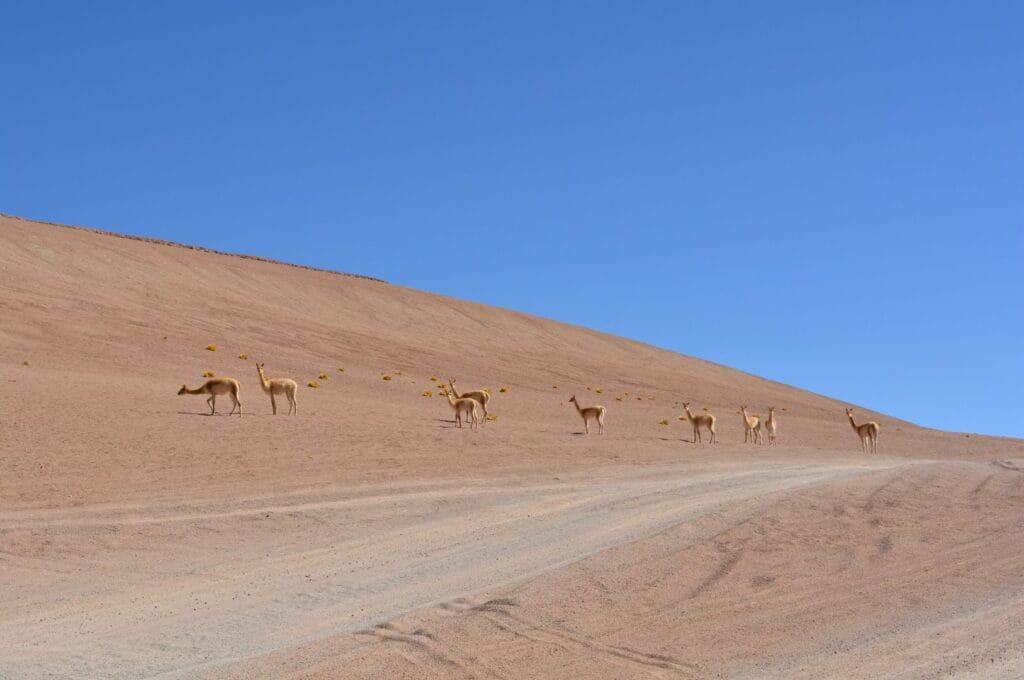
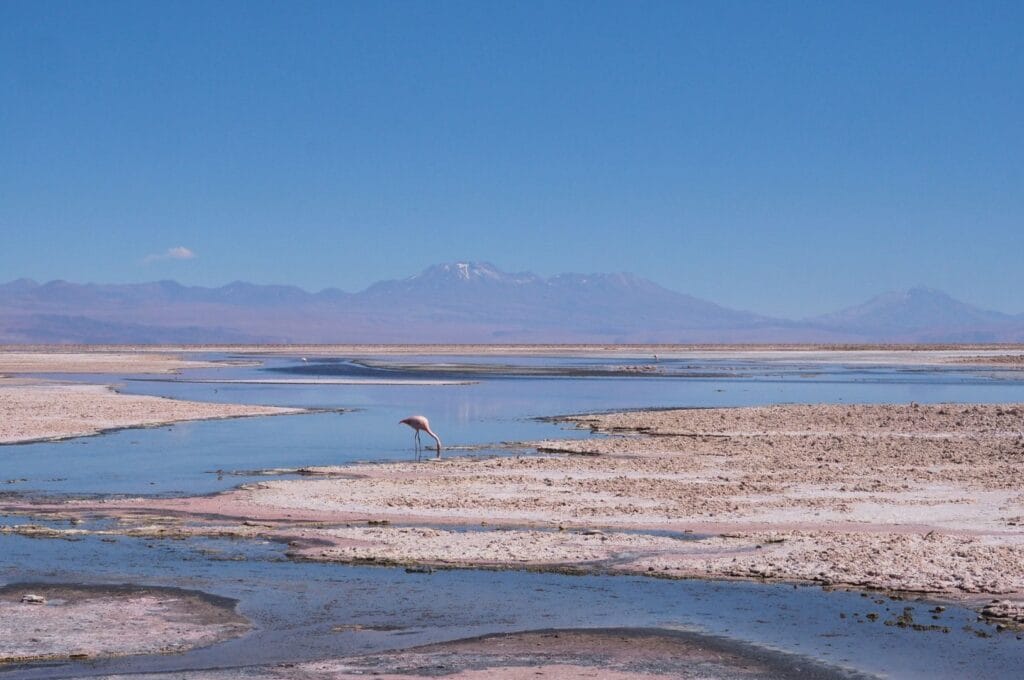
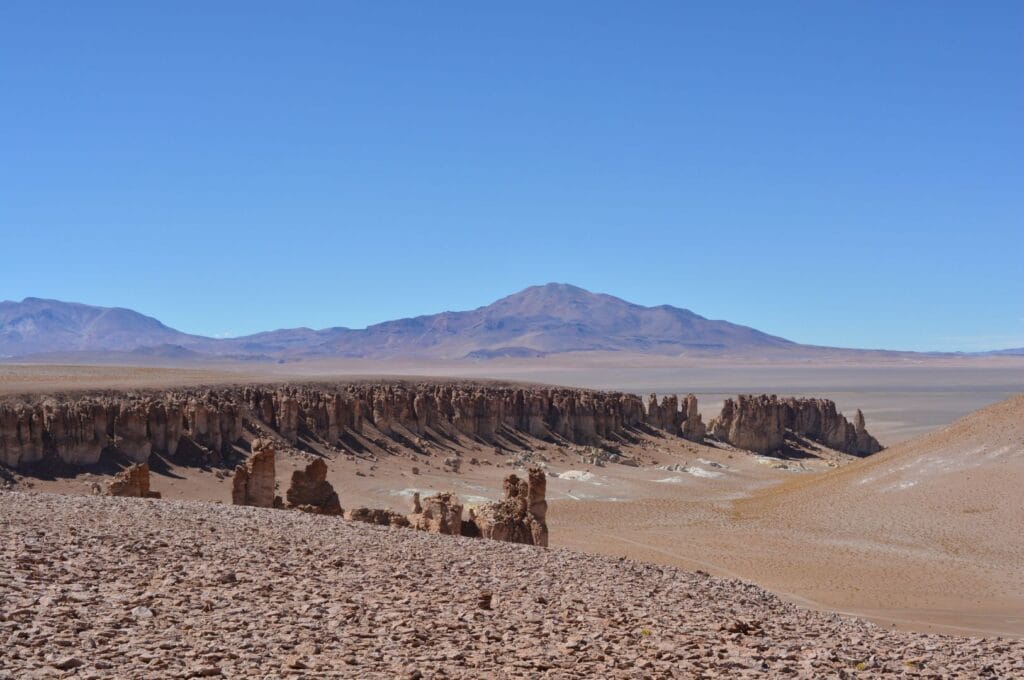
Laguna Aguas Calientes I and the Salar de Tara are among the rare free sites in the Atacama Desert! And when you see the photos, you almost regret not having visited! You can get there on your own or book a guided tour.
Discover the last lagoon at the gates of Argentina
Here’s one last spot to dazzle you before you leave. Continue towards the Argentine border from the Salar de Tara and stop at Laguna Quisquiro. It’s located in the Quisquiro salt flats, also known as Salar de Loyoques. This lagoon is surrounded by trails accessible on foot or by car. Since you’re really far from San Pedro de Atacama, you’ll likely be alone! Plus, entry is free.
Stargaze
The sky over the Atacama Desert is well-known for its clarity. It’s perfect for stargazing at night due to the altitude and lack of light pollution. If you’re passionate about astronomy, be sure to book one of your evenings with experts to gaze at the stars through telescopes! Otherwise, simply step outside each night to see the stars like never before—it’s free! Your mission: find the Milky Way ;).
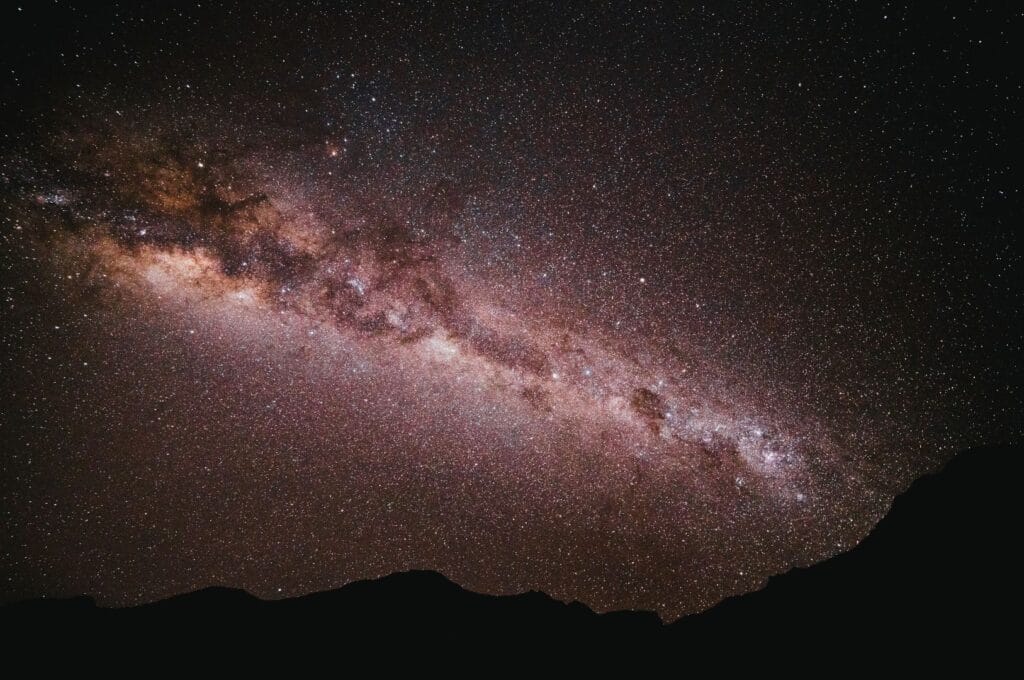
Go hot air ballooning over the Atacama Desert
Flying over Atacama in a hot air balloon is an activity we would have loved to do. However, we were on a tight budget like most backpackers! If you get the chance to experience this unique adventure, go for it! You can find all the details here.
Marvel in Sud Lípez and the Uyuni salt flats
If you’re coming from Chile and want to go to Bolivia, it’s very popular to take a tour from San Pedro de Atacama through the Sud Lípez region and the Uyuni salt flats. Over 3 or 4 days, you’ll be able to admire these fantastic landscapes and arrive directly at the village of Uyuni in Bolivia. However, the prices are slightly higher than in Bolivia.

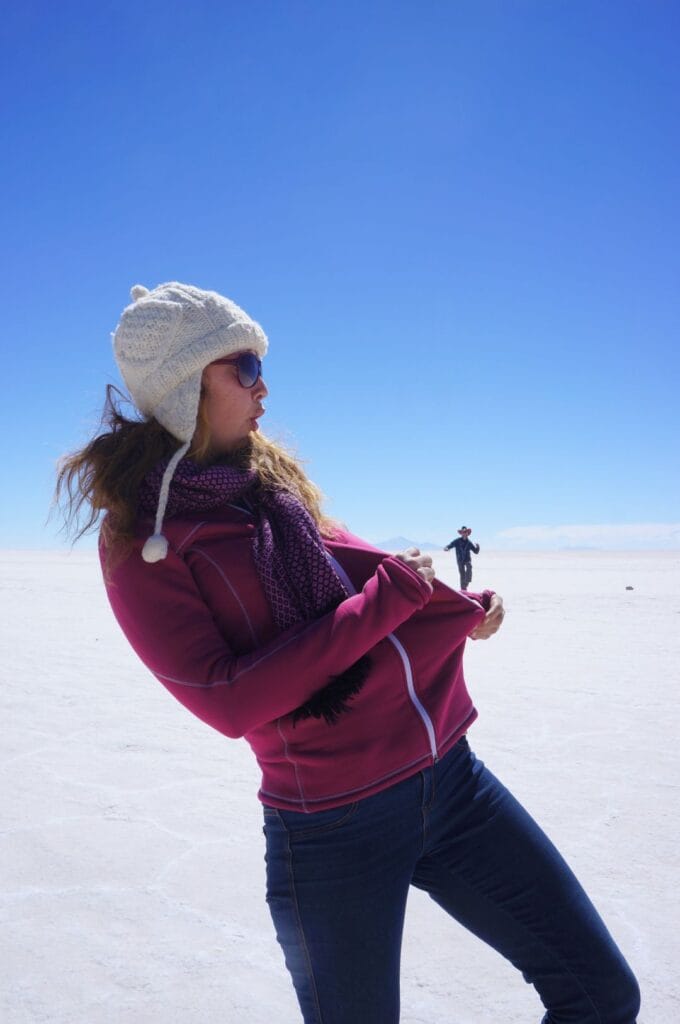
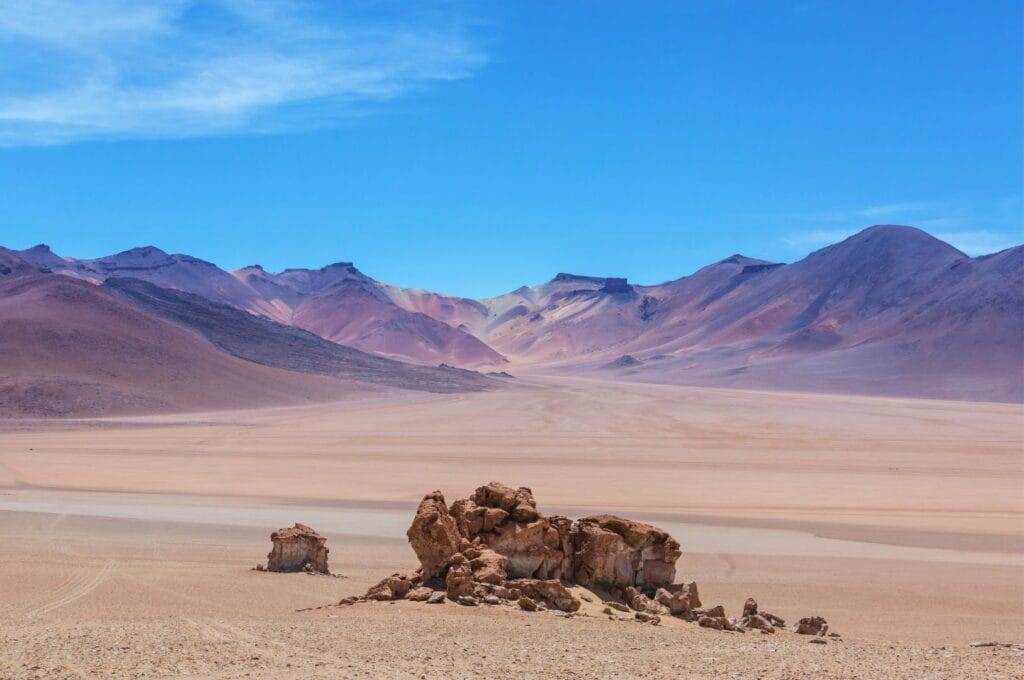
Climb (or watch) a volcano
You may have noticed by now that there’s no shortage of volcanoes in Chile, particularly in this region:
- Licancabur (summit at 5,920 meters, 8 km round trip, 1,300 meters of elevation gain) is the closest volcano to San Pedro de Atacama and straddles the border between Chile and Bolivia, but its ascent is done from Bolivia.;
- this border also passes through Sairecabur (summit at 5,971 meters, 1.8 km round trip, 290 meters of elevation gain), but this time it’s accessed from the Chilean side;
- Cerro Toco (summit at 5,604 meters, 2.7 km round trip, 361 meters of elevation gain, guided hike possible) is 50 minutes east of San Pedro de Atacama; this extinct volcano offers an incredible view of the salt flats from its summit;
- Volcán Láscar (summit at 5,592 meters, 10 km round trip, 670 meters of elevation gain) is the most active volcano in northern Chile, 1 hour 15 minutes southeast of San Pedro de Atacama; the trail leads up to its crater;
- Acamarachi (also called Pili, summit at 6,046 meters, a solid 7 km round trip, and 1,100 meters of elevation gain).
If climbing isn’t your thing, head to the most popular viewpoint to observe Licancabur, 30 minutes east of San Pedro de Atacama.
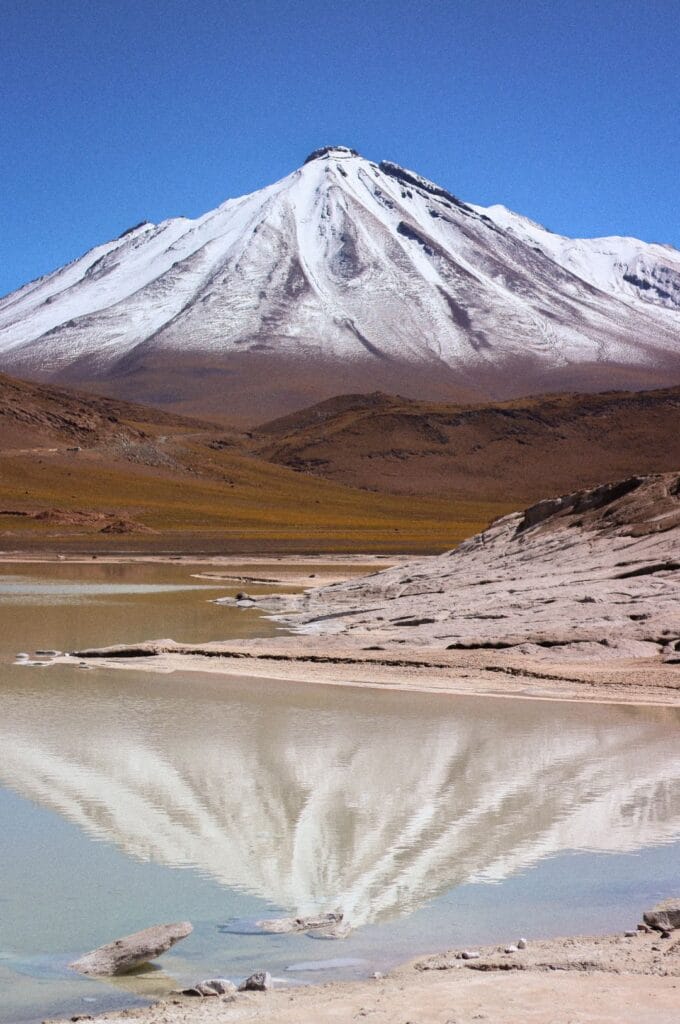
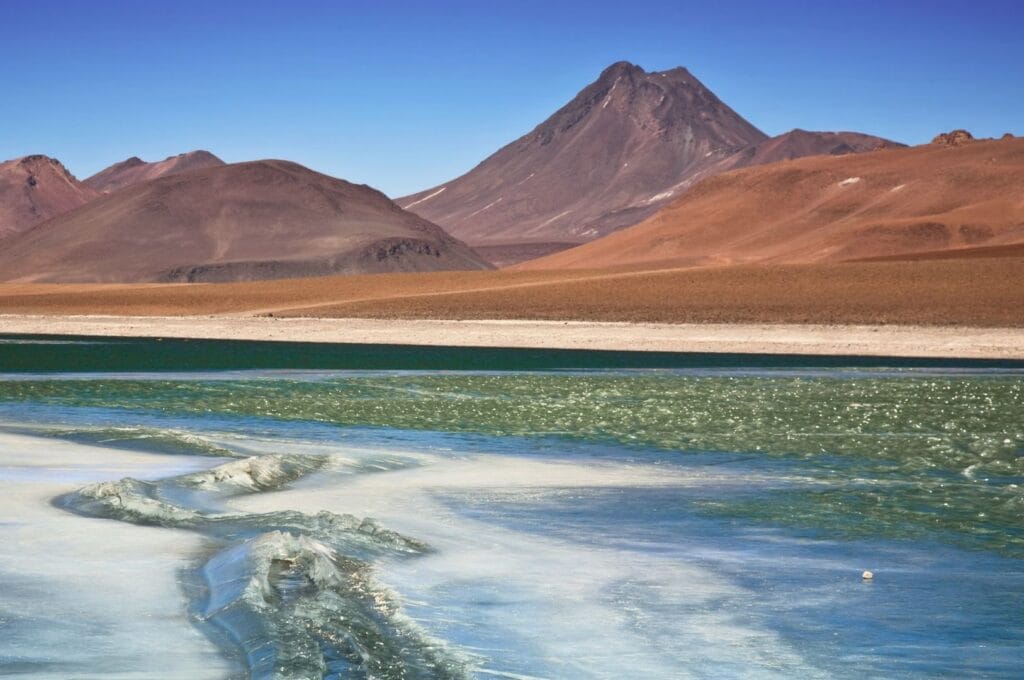
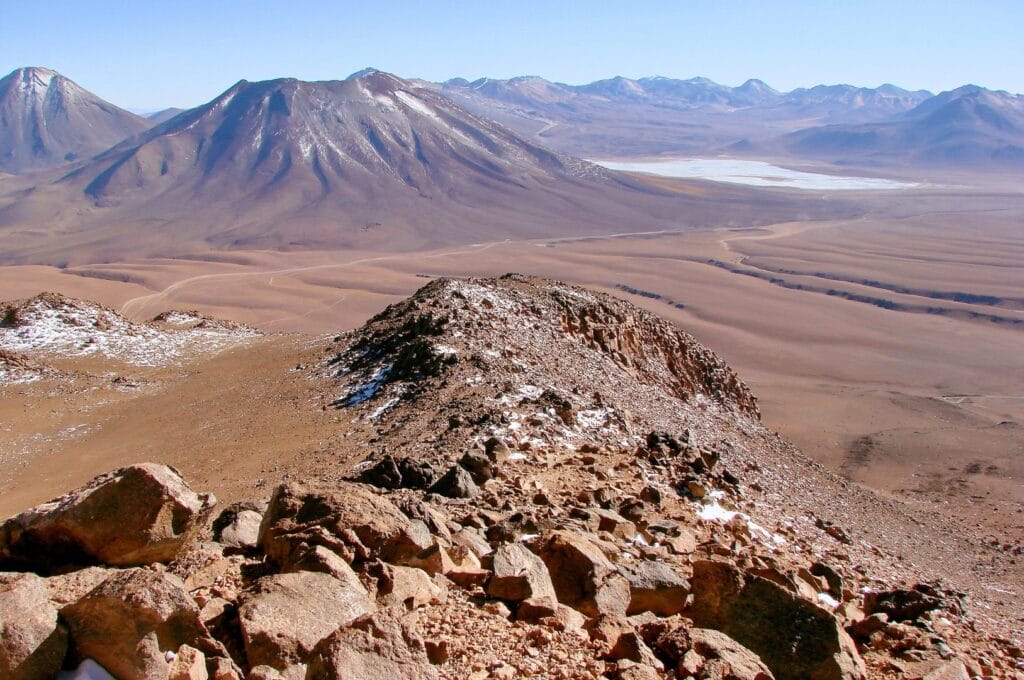
So, those were our four amazing days in the Atacama Desert. Next time, we’ll tell you why we decided to change our plans at the last minute (again) to take a road trip around Salta in northern Argentina instead of following the Chilean coast. But if you’re staying in Chile, see you at the next stop, Valparaíso! And you, what impressed you most in Atacama?
Pin it
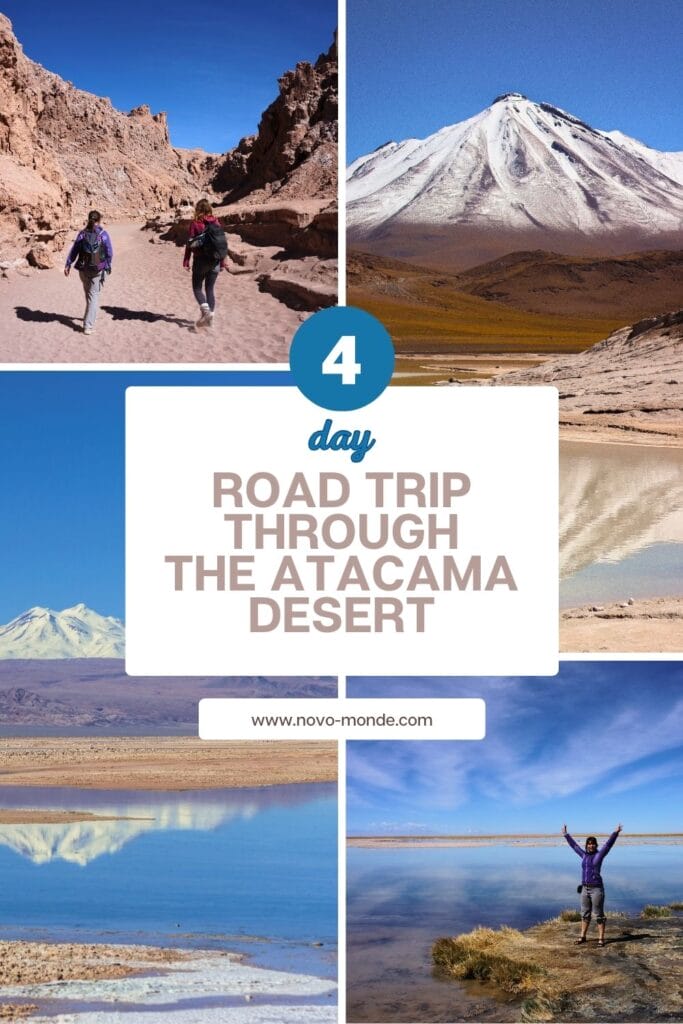
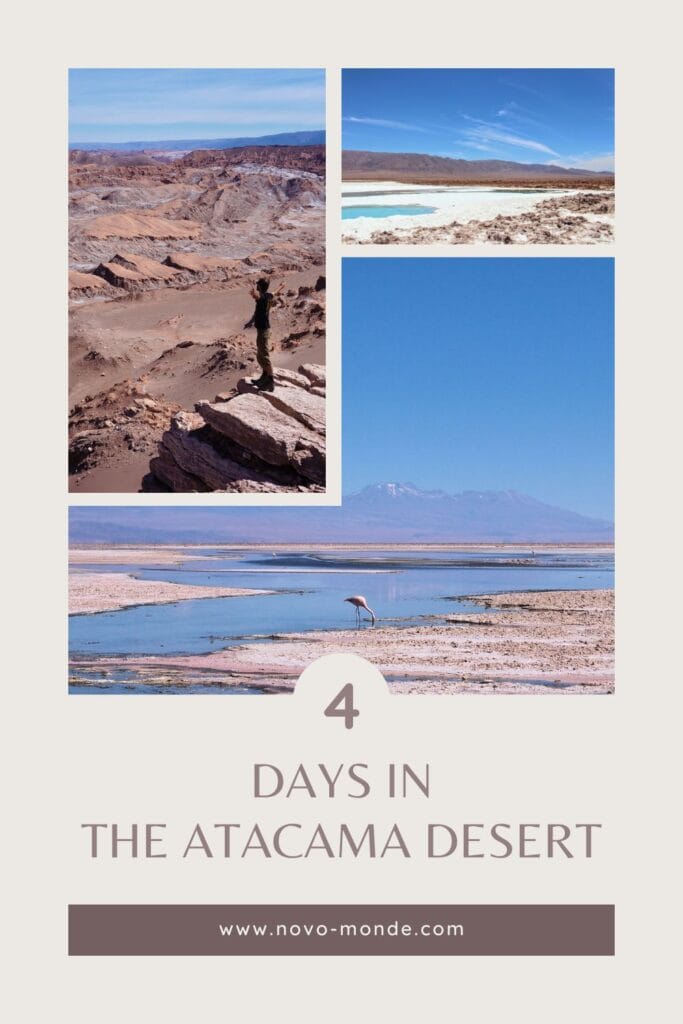
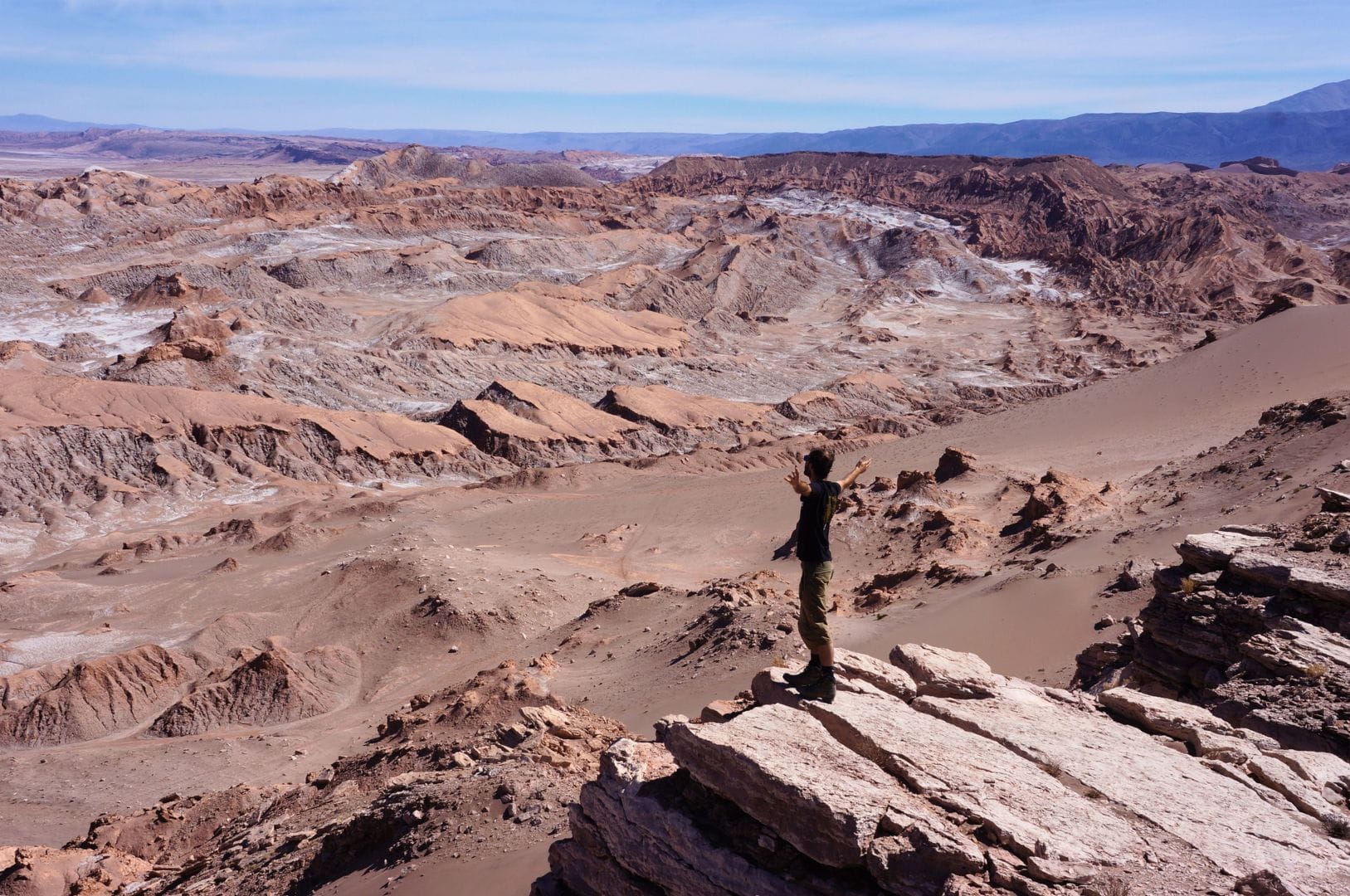

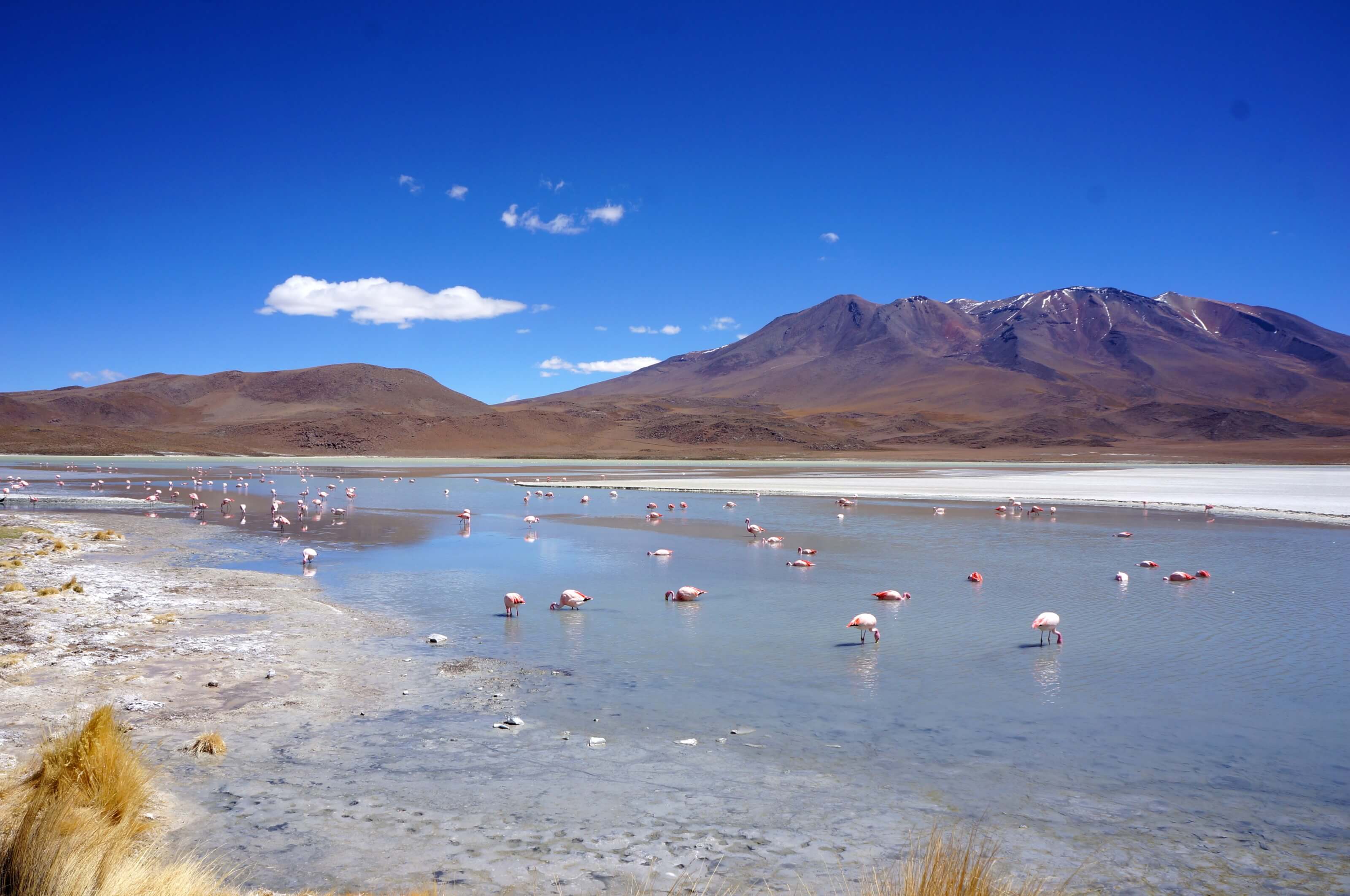
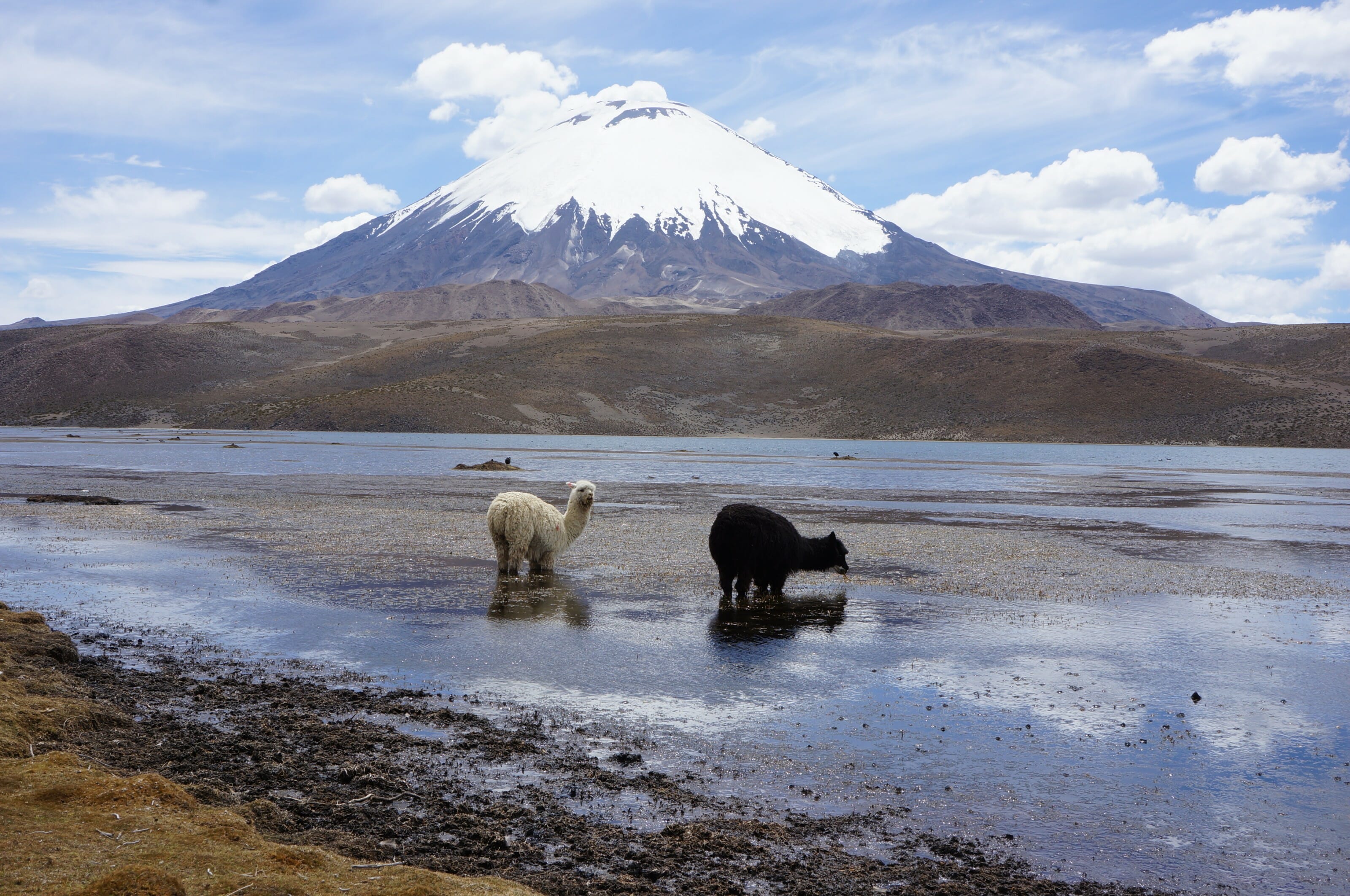
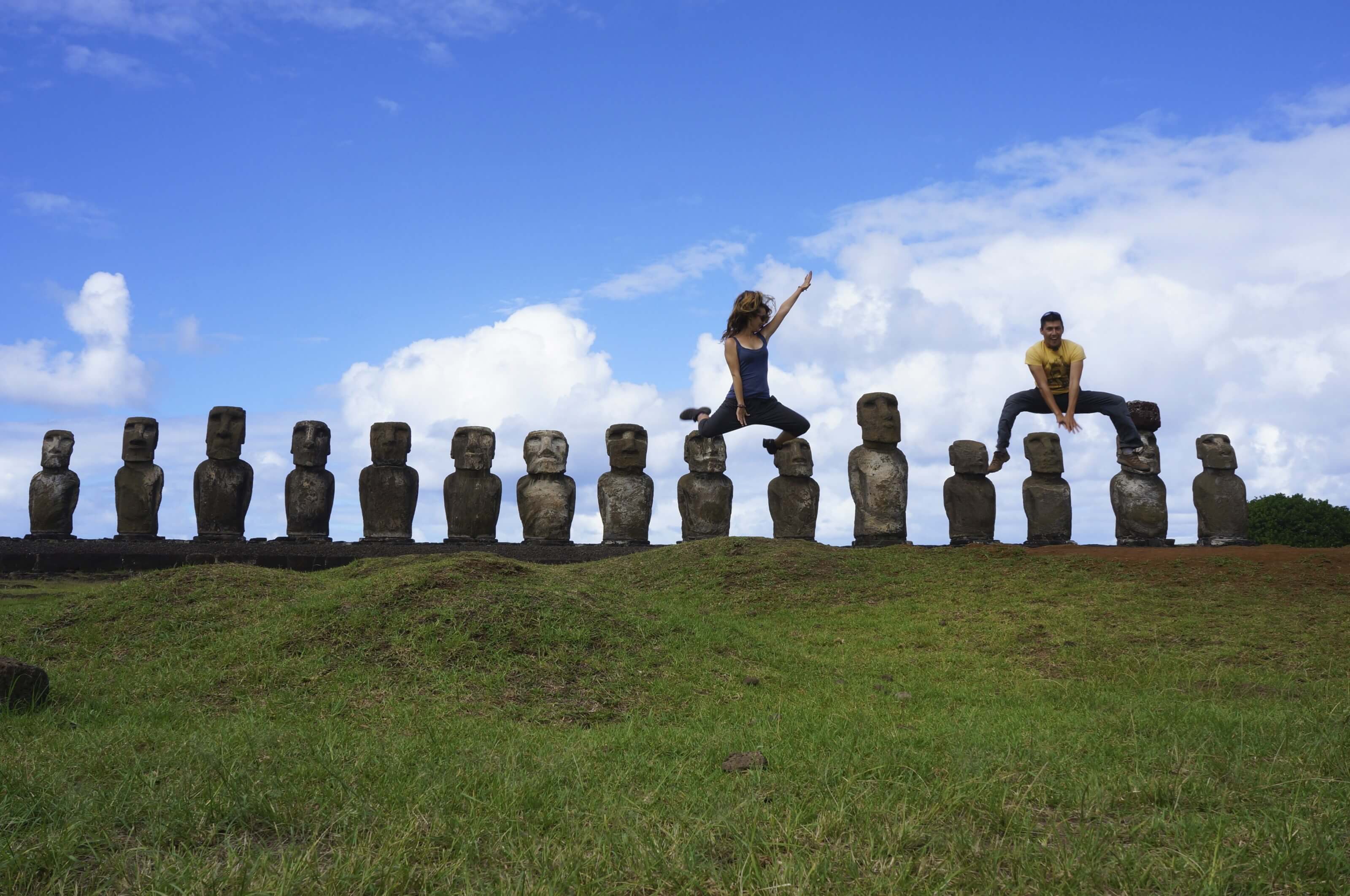
Join the discussion